Warm wood has a way of grounding even the most modern powder room, turning daily routines into small acts of calm. The right wood bathroom vanity pairs organic texture with smart storage, protecting against humidity and wear while telling its own grain-pattern story. Whether you’re drawn to whisper-light oak or coffee-dark walnut, today’s designs make room for every style, size, and budget — often with eco-friendly credentials baked in. Ahead are twenty-five fresh ideas to inspire your next refresh, each one showing how a thoughtfully chosen wooden vanity can lift both looks and function. Let’s dive into the timber treasures waiting to transform your bath.
1. Floating White-Oak Wood Bathroom Vanity Feels Airy
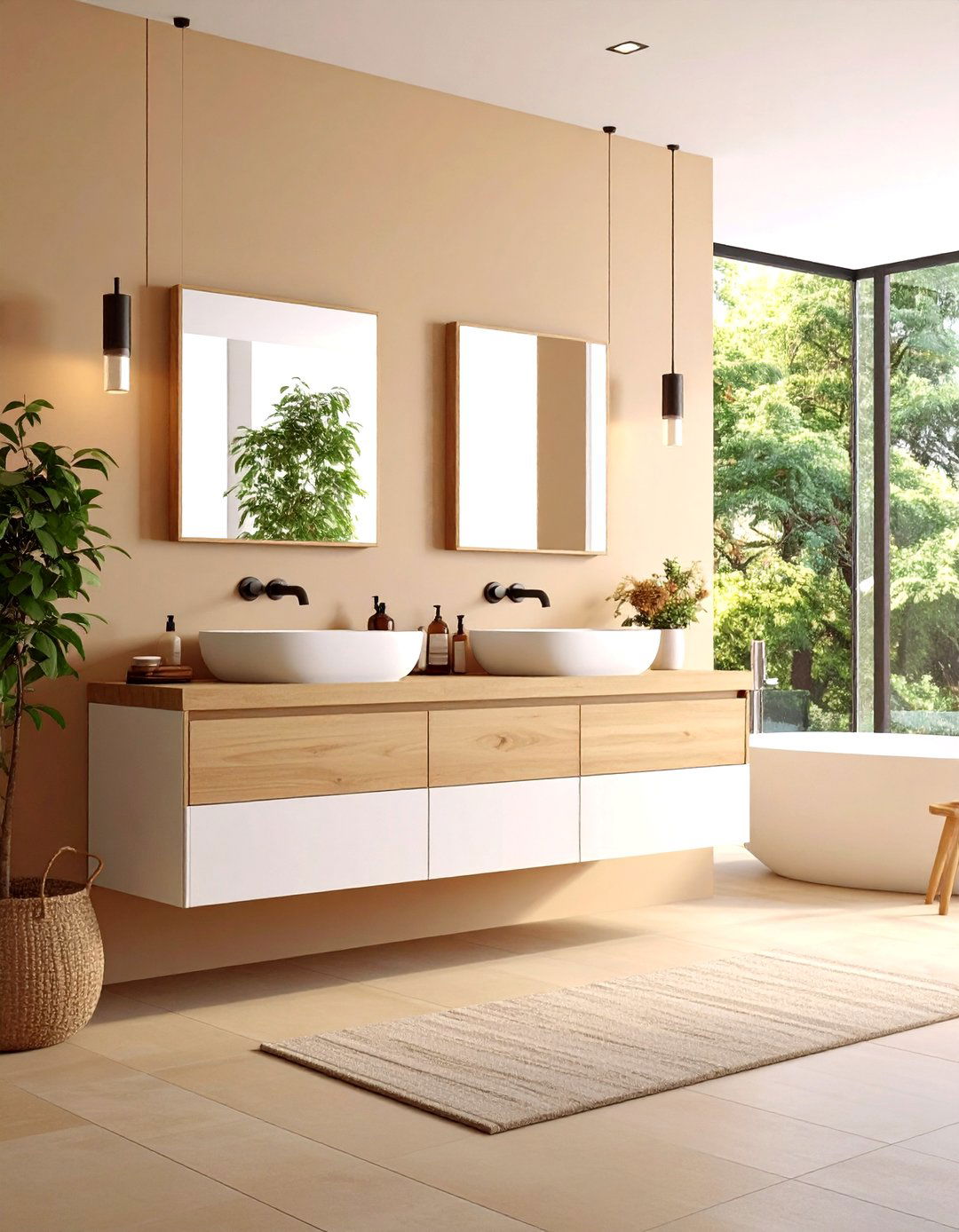
A floating white-oak vanity instantly opens floor space, letting light skim beneath for a spa-like vibe. The wall-mounted silhouette keeps cleaning simple, while oak’s tight grain shrugs off splashes with a quick wipe. Choose a clear matte sealer that highlights warm honey tones, then pair with a slim trough sink so counters stay sleek. Because plumbing tucks neatly behind soft-close drawers, you gain hidden storage without bulky side panels. Many 2025 models even include built-in USB ports inside a power drawer — perfect for charging razors or toothbrushes out of sight. Finish with minimalist pulls to keep the timber front and center.
2. Reeded Wood Bathroom Vanity Adds Elegant Texture
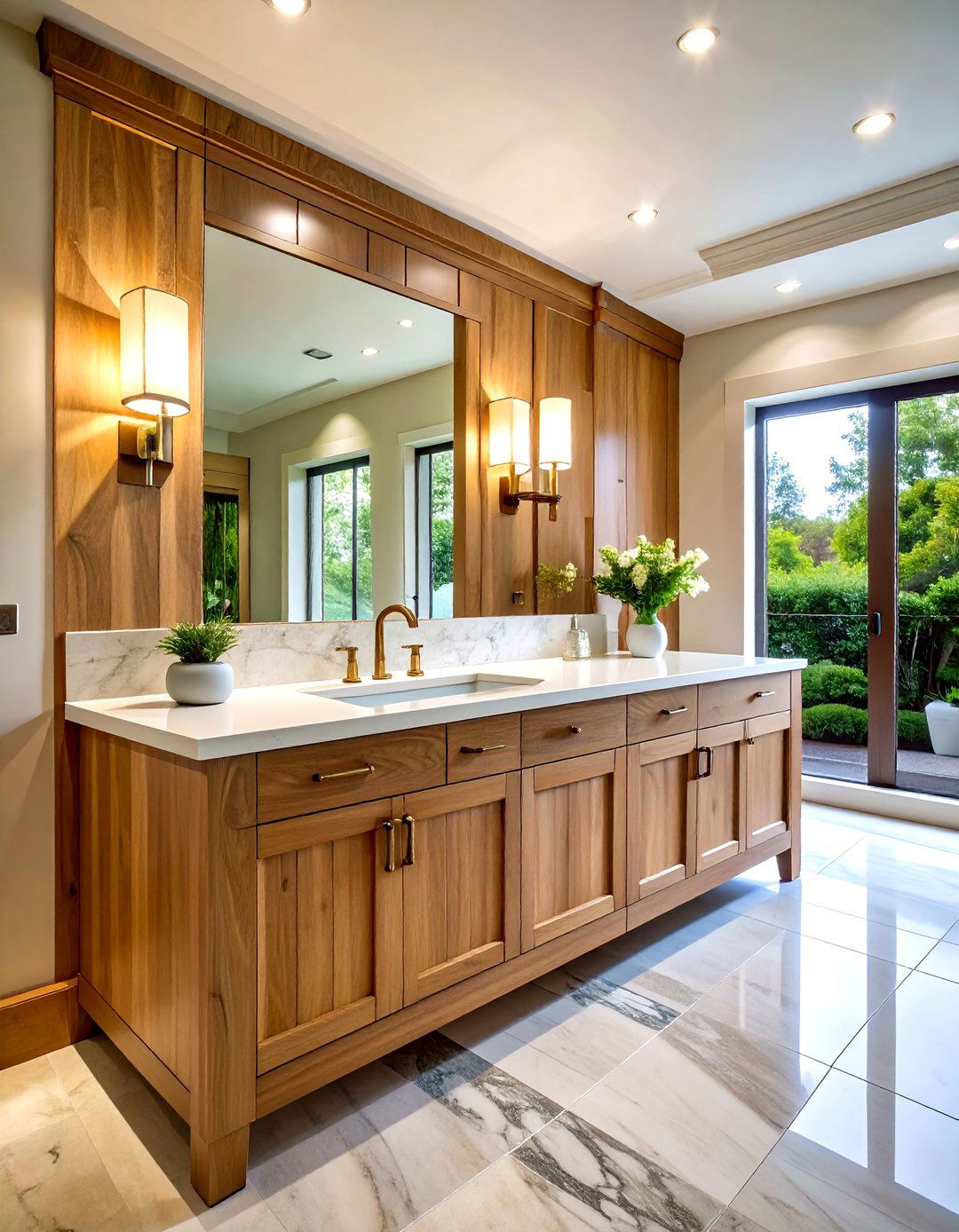
Unlike flat slab fronts, reeded or fluted wood vanities introduce gentle rhythm through vertical grooves that catch shifting light. The subtle pattern hides fingerprints and water marks better than smooth panels, making upkeep painless. Opt for white oak, ash, or even walnut veneers over moisture-resistant plywood to balance cost and durability. Regulation-height legs prevent toe stubs while preserving that furniture-style feel. Brass edge pulls slip neatly into the flutes so hardware doesn’t compete with the grain. Because the look already carries visual interest, keep countertops simple — think solid quartz or honed marble — in order to let the sculpted timber steal the show.
3. Minimalist Slab-Front Wood Bathroom Vanity Hides Clutter
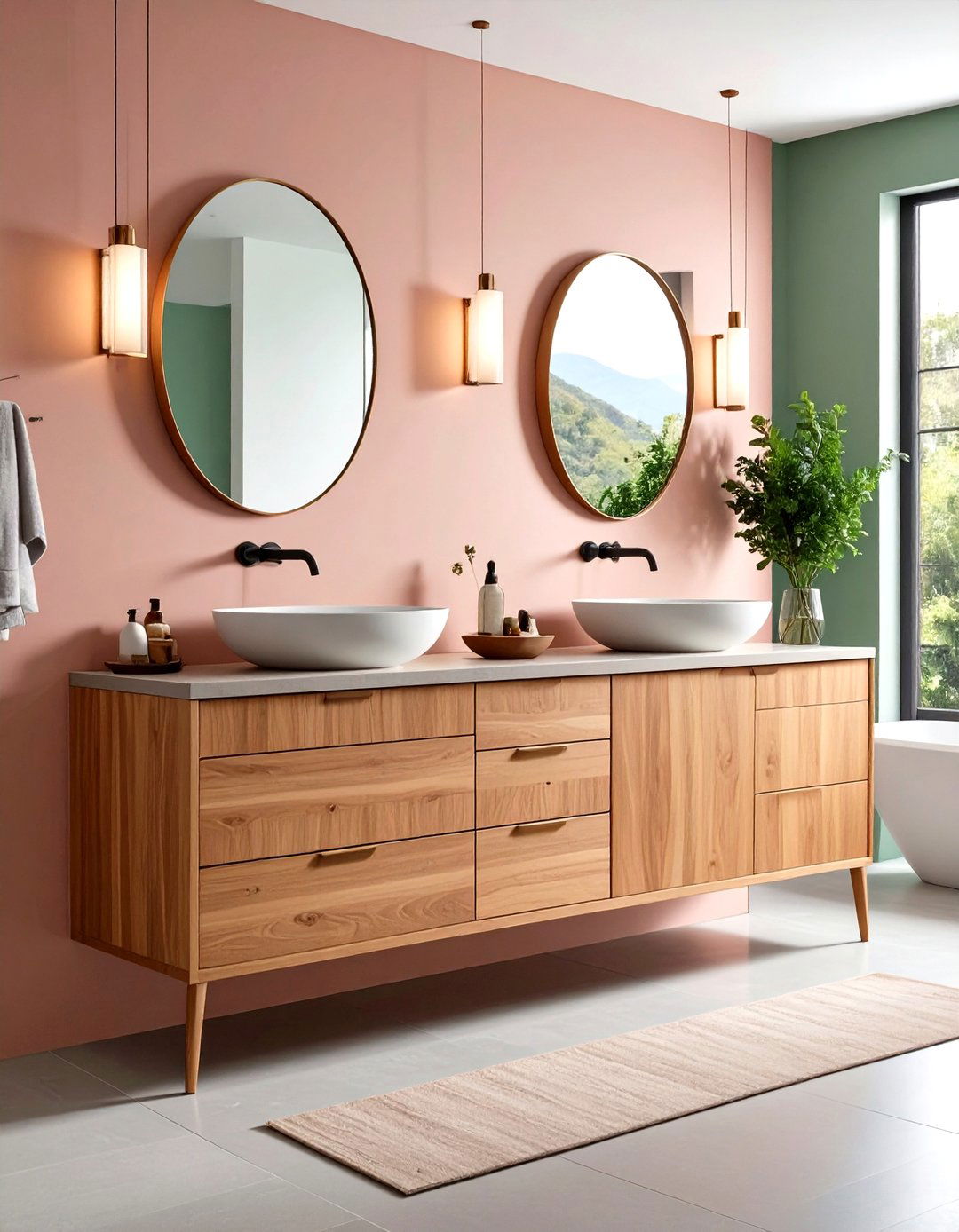
The straight-lined, handle-free vanity reigns in 2025 bathrooms focused on calm. Push-latch doors and fingertip reveals create a seamless facade, allowing the wood’s natural character to speak without interruption. Inside, shallow drawer organizers corral makeup and grooming gear, while an inset shelf lifts cleaning bottles above the plumbing trap. Pair the vanity with a wall-mounted faucet to keep that sweep of unbroken countertop. If space allows, choose a slightly longer size than usual; minimalist designs thrive on negative space around the edges. Finish with warm LED under-glow to highlight the floating form at night.
4. Rich Walnut Wood Bathroom Vanity Brings Cozy Warmth
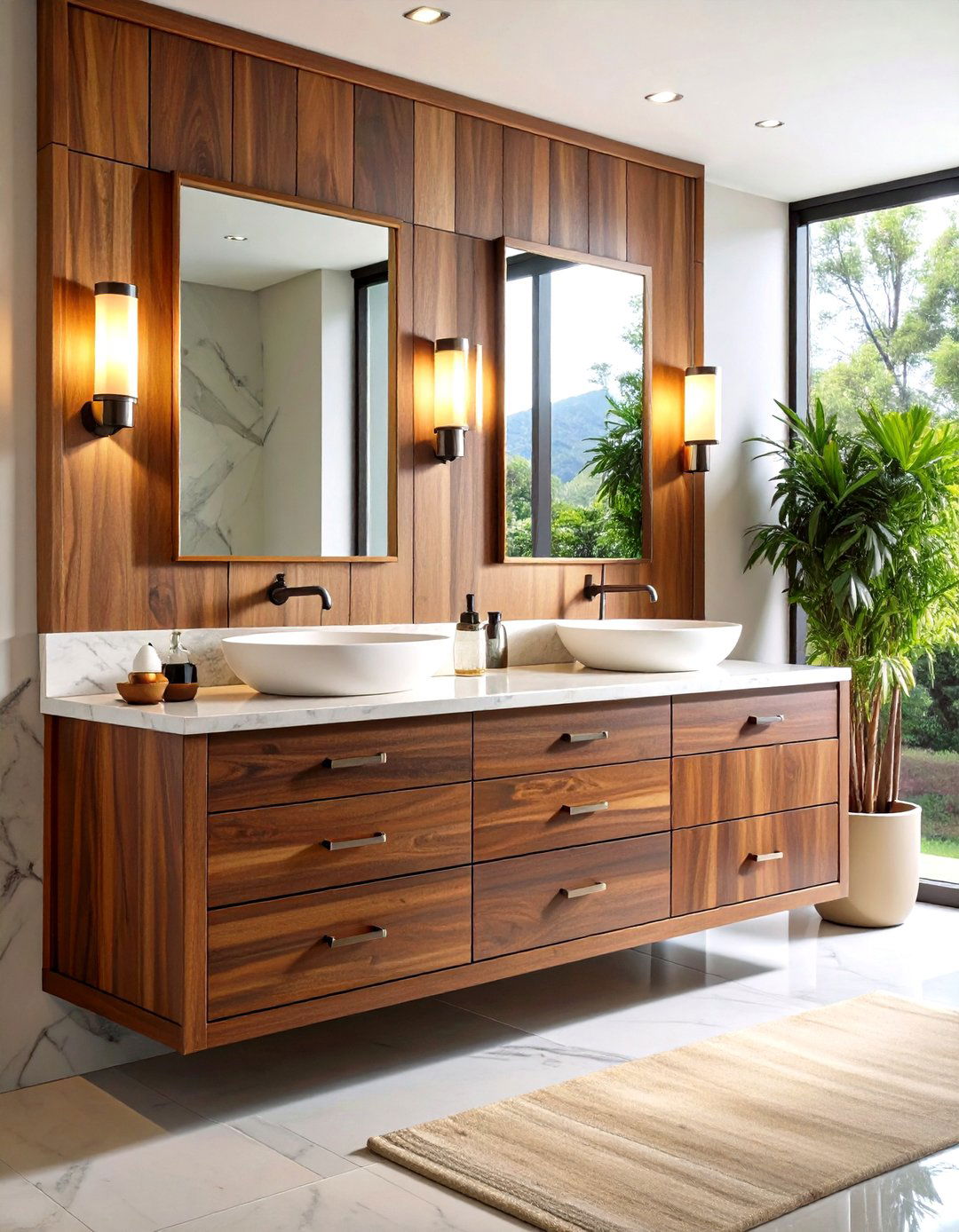
For anyone craving depth, a walnut vanity delivers chocolate-hued grain and instant sophistication. Current trends favor book-matched drawer fronts, where mirrored veneers create a gentle butterfly pattern across the face. To keep the darker timber from feeling heavy, mount the unit a few inches off the floor and add a frameless mirror that reflects light back into the room. Brass or black-bronze hardware complements walnut’s warm undertone, while creamy marble counters provide contrast. If budget is tight, look for engineered walnut veneers over stable MDF cores — they’re less prone to seasonal movement yet preserve that luxurious café-brown look.
5. Eco-Friendly Bamboo Wood Bathroom Vanity Offers Spa Serenity
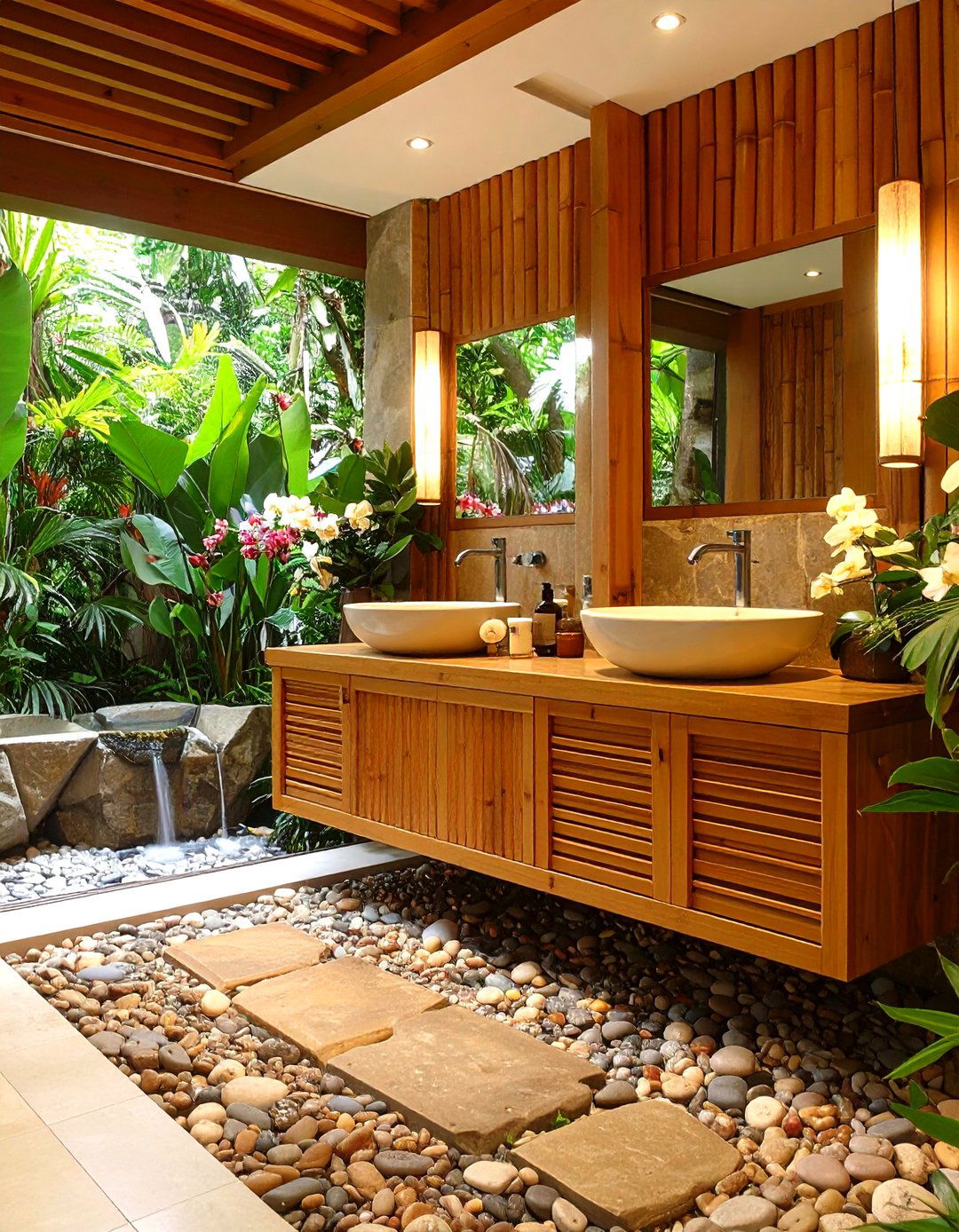
Surprisingly sturdy for a grass, bamboo earns top marks for sustainability thanks to its rapid growth cycle. Many manufacturers cross-laminate strips to improve dimensional stability, then seal with low-VOC finishes that resist mildew. Natural caramel bamboo pairs effortlessly with stone pebble floors and a rainfall shower for full spa ambience. Because bamboo accepts both stain and paint, you can shift the tone — from soft ash to deep espresso — without risking warping. Add slatted open shelving below to showcase rolled towels, emphasizing the material’s tropical roots. Install a low-flow faucet to complete the greenhearted ensemble and keep water waste in check.
6. Double-Sink Floating Wood Bathroom Vanity Streamlines Mornings
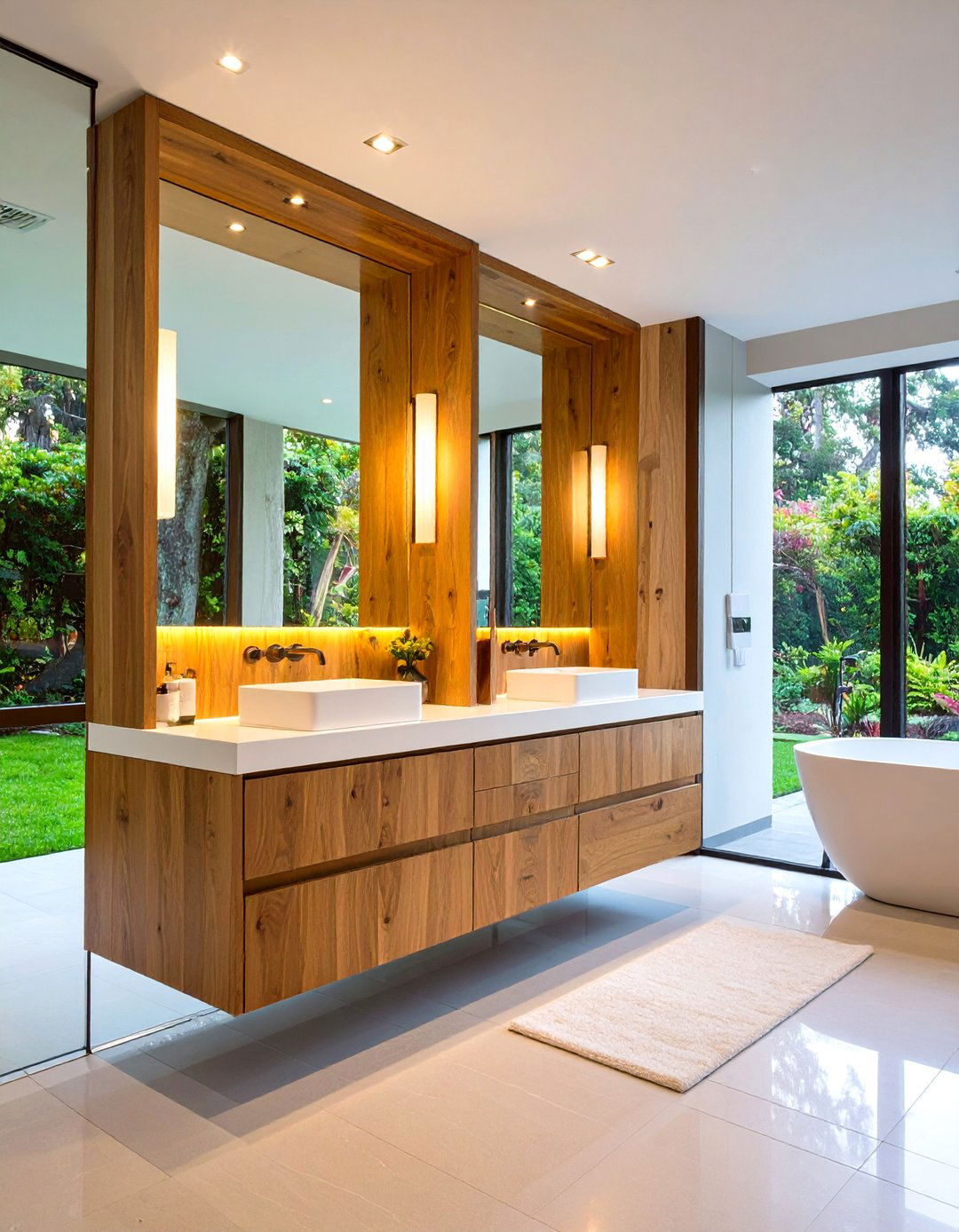
Busy households benefit from twin basins set into one continuous wooden carcass. A 72-inch-wide floating frame leaves ample knee clearance while offering separate storage towers at each end. Soft-close doors dampen early-hour clatter, and a central cutout drawer neatly corrals shared toiletries. Look for moisture-sealed white oak or maple interiors so drips won’t swell shelves. Top with an easy-clean solid-surface deck featuring integrated sinks to reduce caulk lines. Wall-mounted faucets free up counter space, and LED strip lighting beneath the valance helps sleepy eyes navigate those dawn routines without blinding brightness.
7. Rustic Reclaimed-Wood Bathroom Vanity Channels Farmhouse Charm
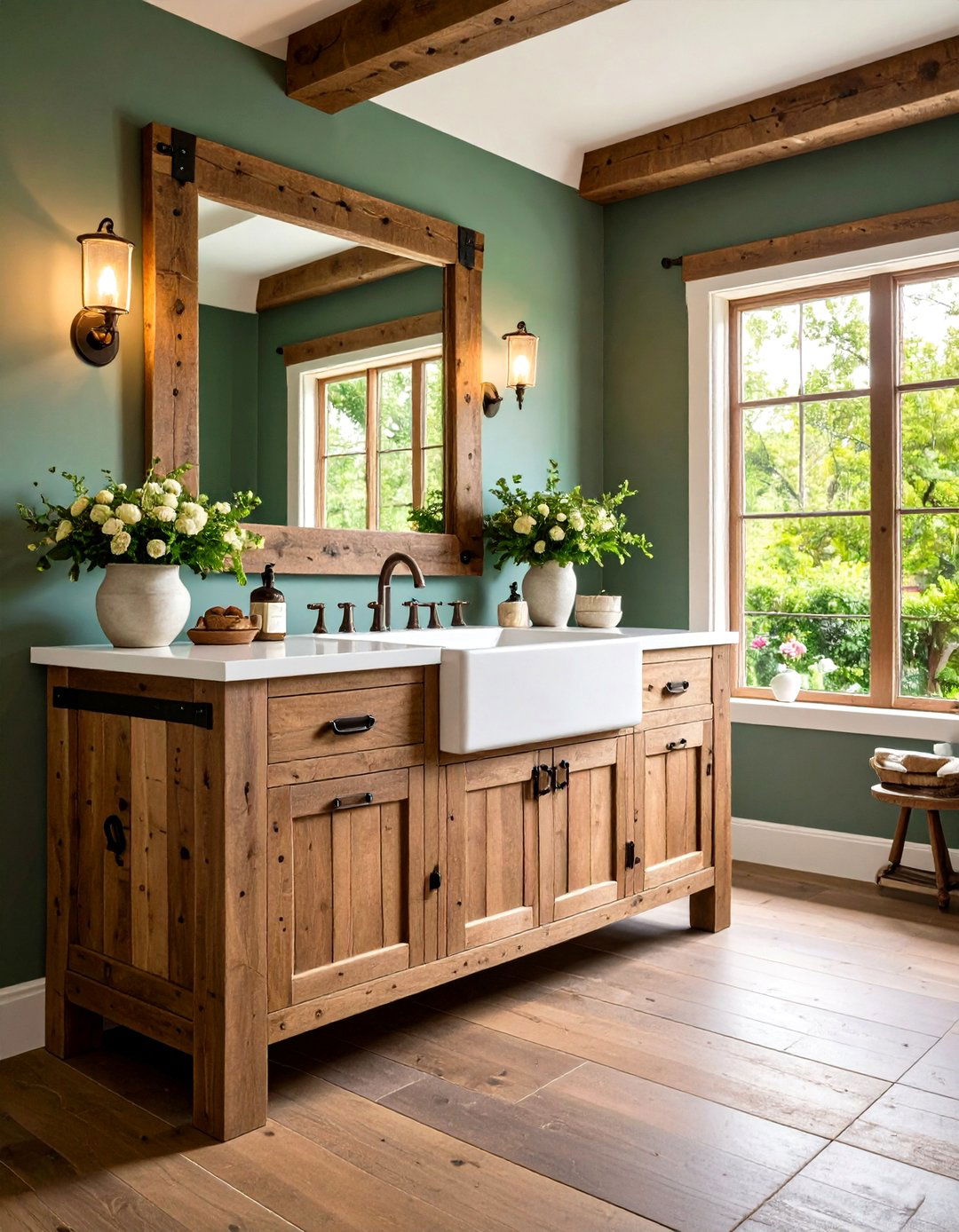
A vanity built from salvaged barn boards tells a sustainability story and brings instant soul to a bath. Weather-softened pine or oak planks gain a second life once planed, sealed, and framed into a sturdy carcass backed with marine-grade plywood. Keep the original nail holes and saw marks visible beneath a matte water-based polyurethane to showcase character. Forged-iron strap hinges and cup pulls reinforce the farmhouse vibe, while a rectangular porcelain sink modernizes function. Because reclaimed lumber can be porous, apply a penetrating sealer every year to prevent moisture creep and preserve that timeworn patina.
8. Black-Stained Oak Wood Bathroom Vanity Makes a Bold Statement
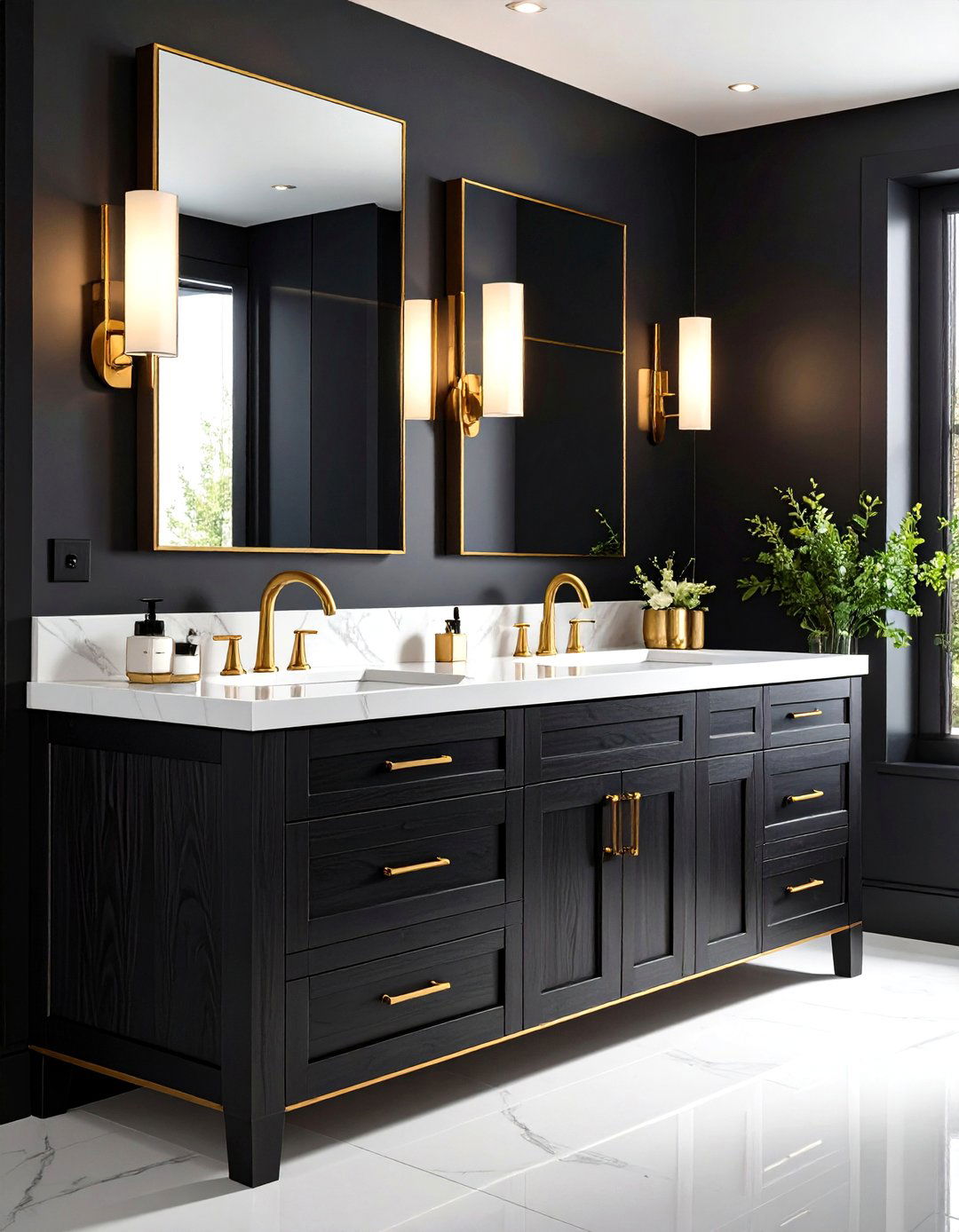
When you crave drama without leaving natural materials behind, ebony-staining an oak vanity delivers serious impact. The dark finish outlines grain just enough to reveal texture under bright task lighting. Pair with brushed-gold faucets for contrast and install a crisp white quartz top to keep the ensemble from feeling too moody. Recessed finger pulls maintain a minimalist look while protecting the finish from hardware scratches. Because black absorbs light, add a large backlit mirror or skylight to balance the palette. Regular wipe-downs with a damp microfiber cloth will maintain the deep sheen without streaks.
9. Mid-Century Teak Wood Bathroom Vanity Nods to Retro Cool
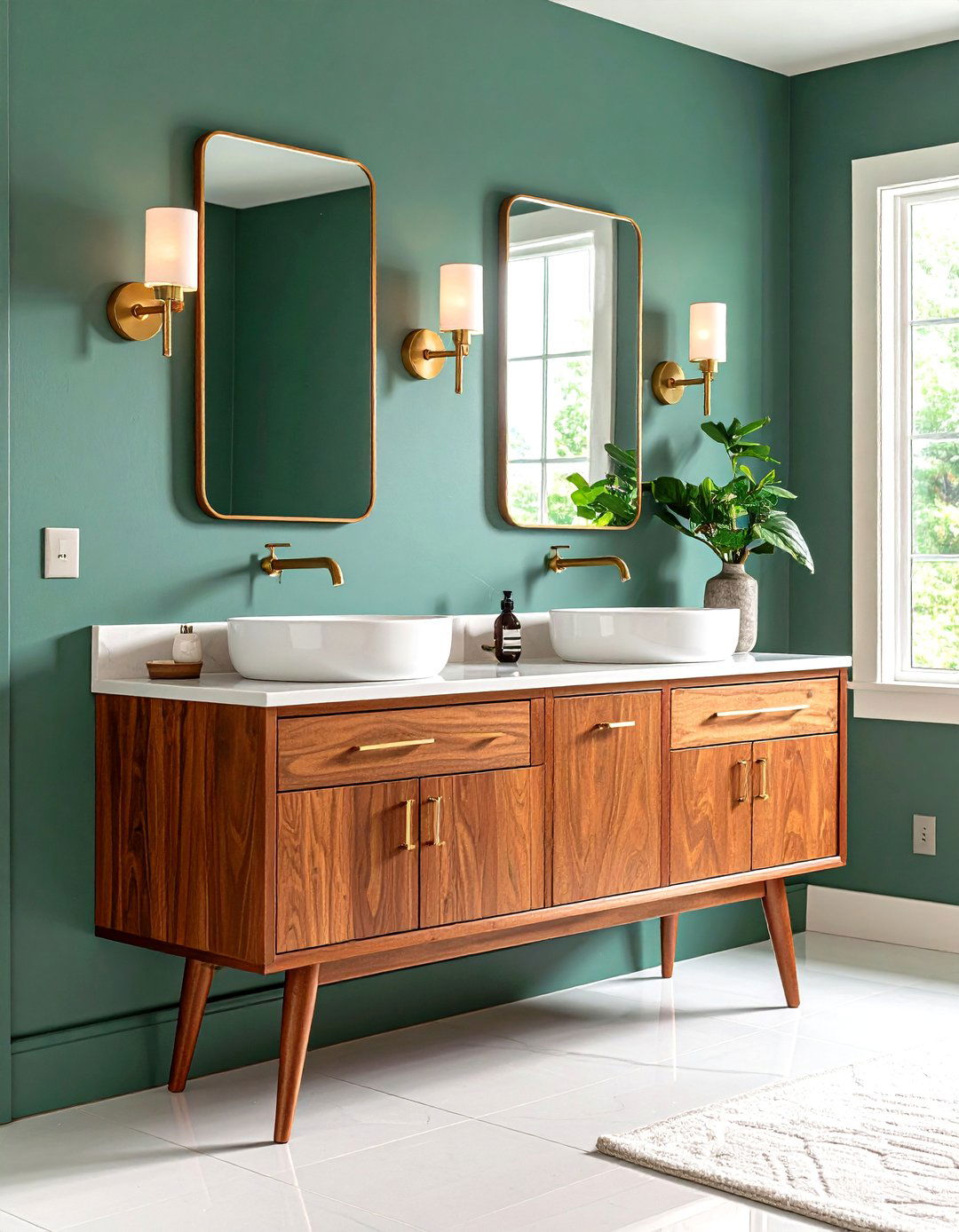
Teak’s natural oil content makes it a classic for boat decks — and an equally smart pick for steamy bathrooms. A tapered-leg console vanity channels 1960s design and keeps sightlines open in small spaces. Choose slim horizontal pulls and flat-front doors to stay true to the era. A white round vessel sink enhances the vintage look, while wall sconces with brass accents echo the warm teak tone. Because genuine teak can be pricey, investigate FSC-certified veneers over plywood cores for budget-friendly authenticity. Finish with a satin sealer that preserves the golden hue before it gently deepens over time.
10. Corner Fluted Wood Bathroom Vanity Saves Precious Floor Space
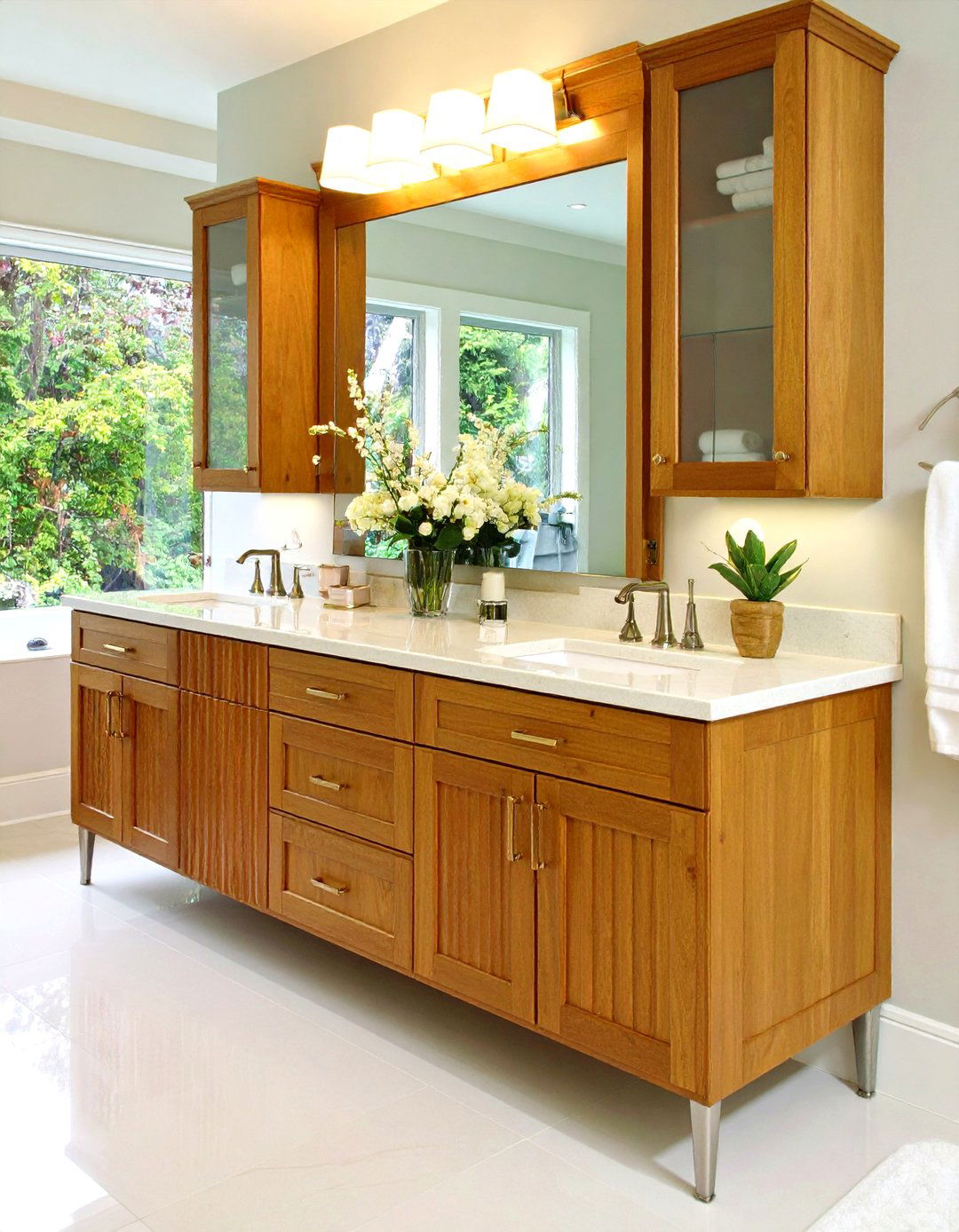
Small bathrooms often waste the corner between door and shower; a custom fluted-front triangle vanity reclaims it beautifully. The faceted grooves lend sculptural intrigue, while the angled carcass maximizes depth for hidden bins behind soft-close doors. Mount the piece on slim metal legs to lighten the visual weight, then choose a rounded-edge quartz top to soften the geometry. Wall-mount the faucet to keep the tiny counter clear, and install a tall mirrored medicine cabinet above to amplify light. Finish by painting the adjacent walls a pale tone so the richly textured wood remains the star.
11. Live-Edge Wood Bathroom Vanity Celebrates Organic Lines
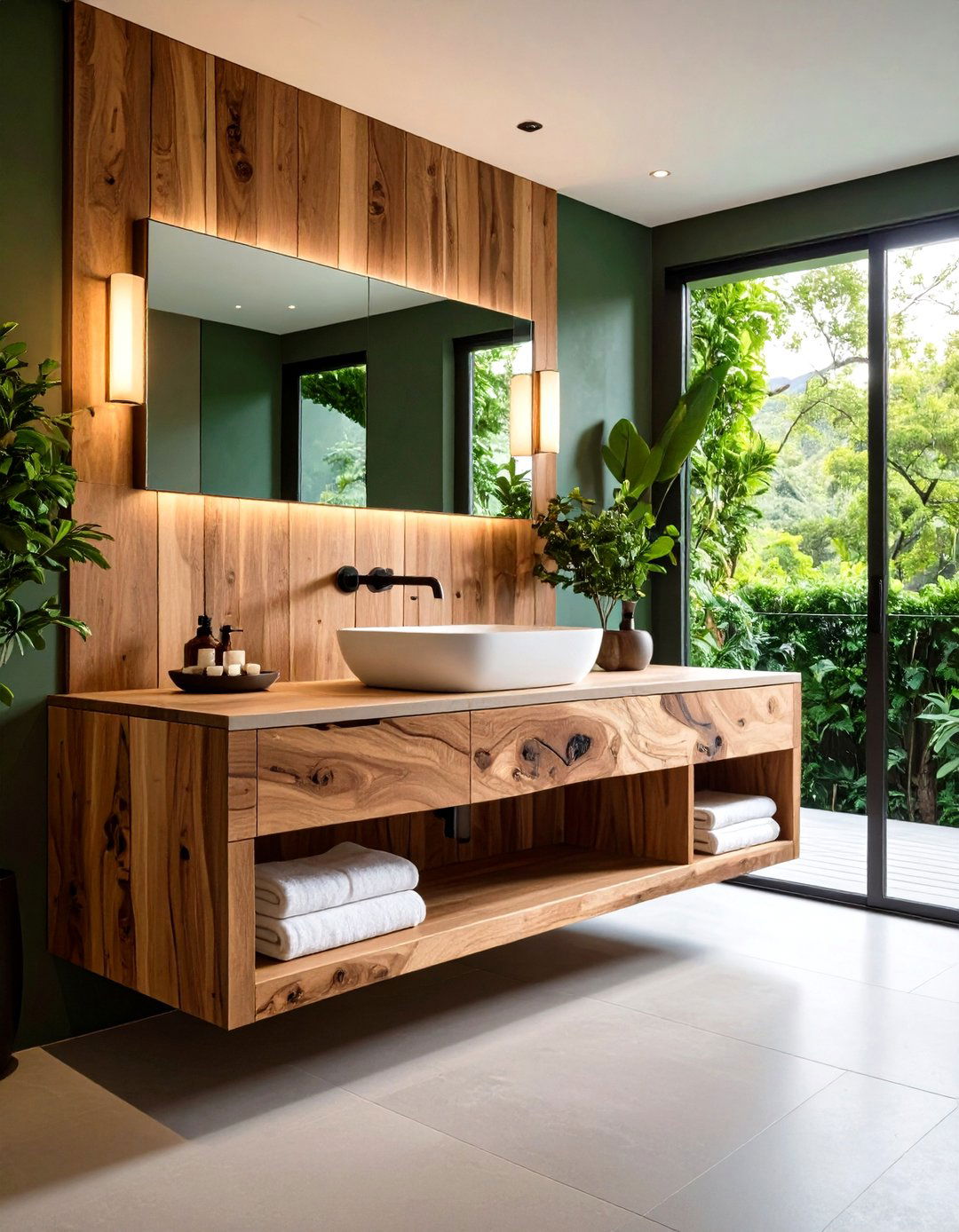
Nothing beats the raw drama of a slab vanity that preserves the tree’s outer curve. Select kiln-dried hardwood — walnut, acacia, or maple — at least two inches thick for stability. Craftspeople fill checks with clear epoxy, then sand to baby-smoothness before sealing with penetrating oil that repels splashes while keeping the surface tactile. Pair with an undermount sink so the live edge sits unobstructed across the front. Because the slab often runs long, add open cubbies beneath for baskets or extra toilet paper. Minimal black plumbing lets the swirling grain and natural edge dictate the visual narrative.
12. Integrated Towel-Ledge Wood Bathroom Vanity Keeps Linens Handy
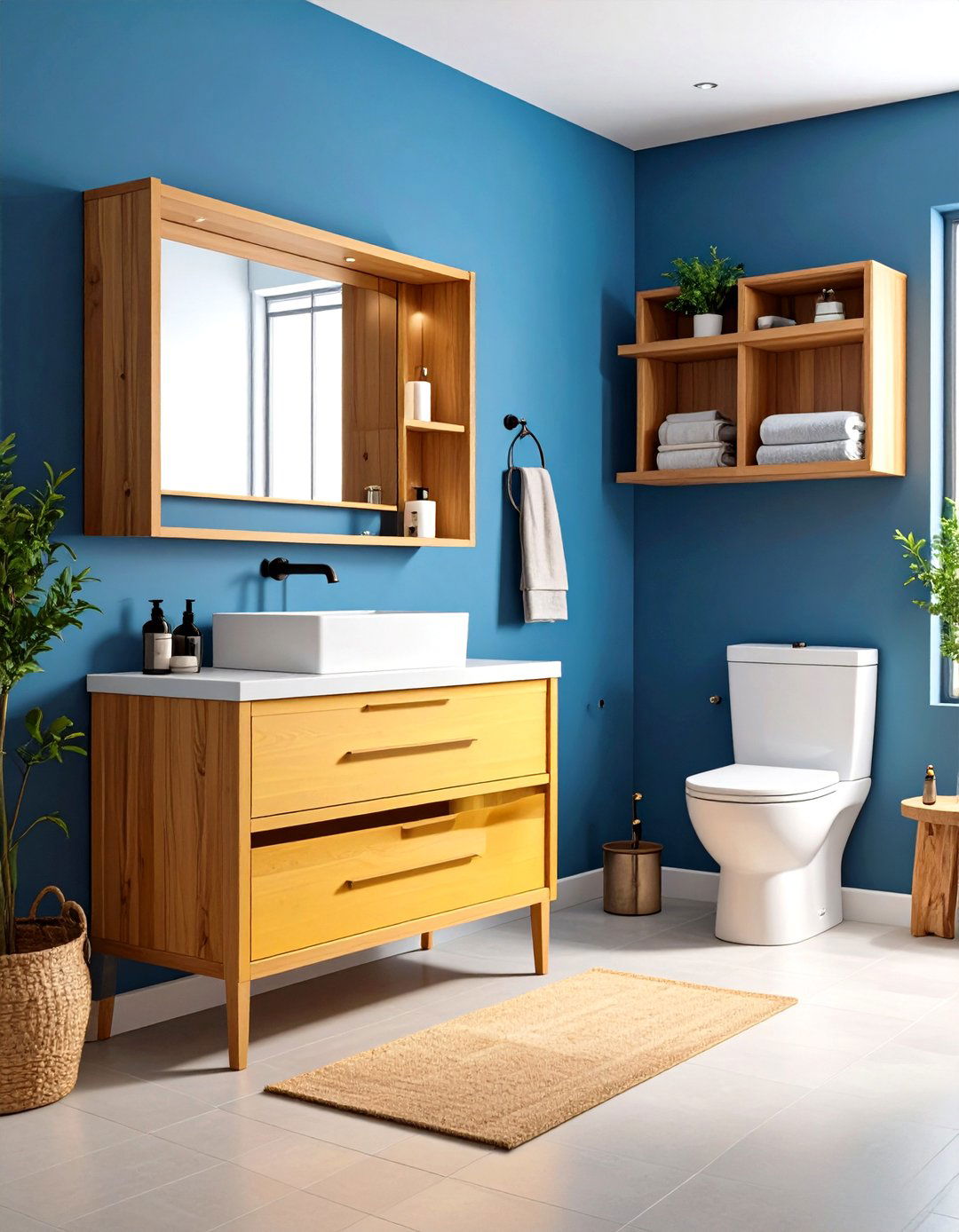
For streamlined morning prep, build a shallow ledge that cantilevers off the vanity’s side to cradle hand towels within arm’s reach. The feature works especially well on minimalist oak or maple boxes where hardware is minimal. Choose a rounded bullnose profile on the ledge to avoid snagging fabric, and line the bottom with hidden rubber bumpers to prevent drips on the floor. Because towels dry faster when exposed to air, this setup also cuts mildew risk. Coordinate the timber tone with floating shelves above the toilet to create a cohesive wood accent line across the room.
13. Vintage Dresser-Turned Wood Bathroom Vanity Adds Character
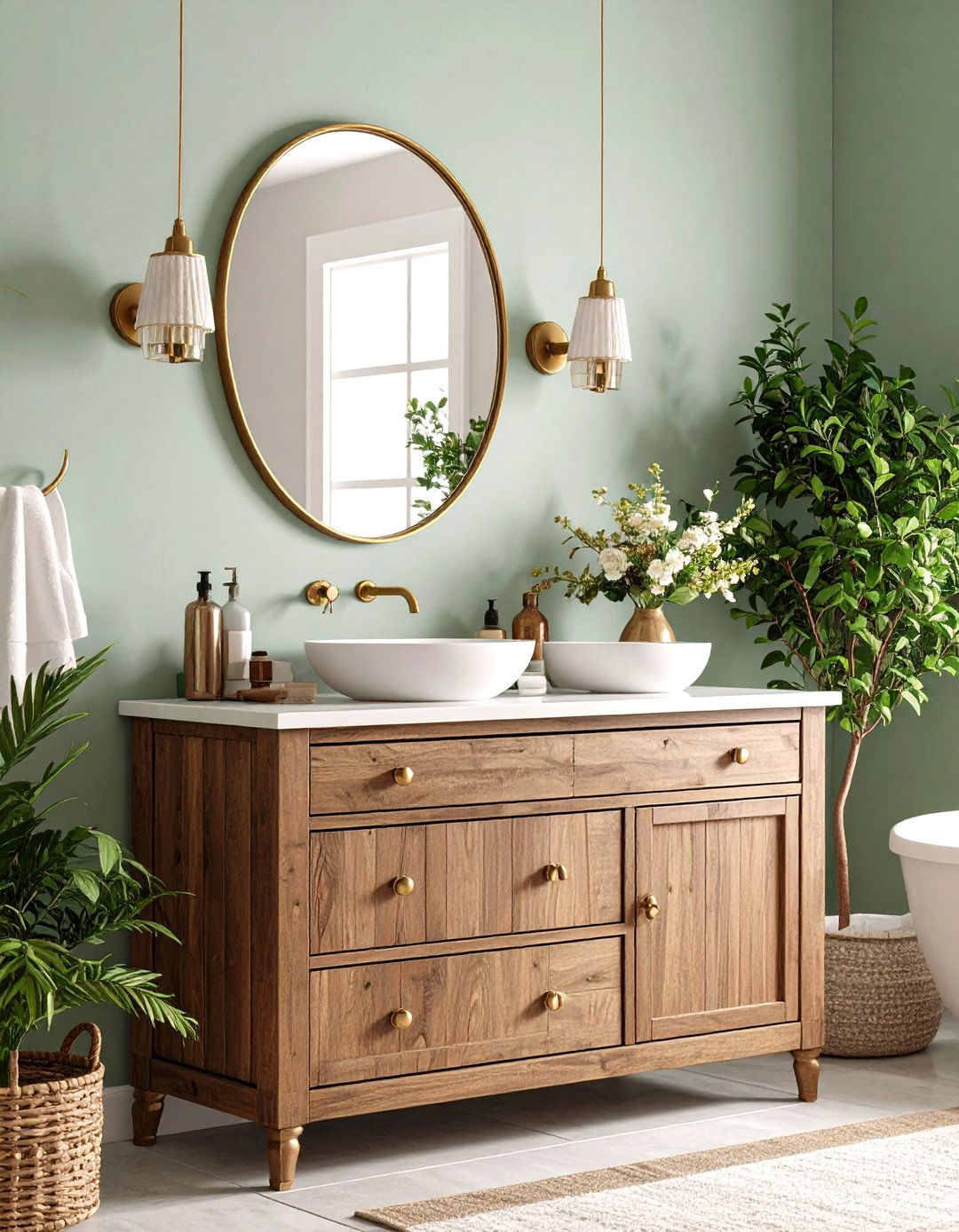
An antique dresser outfitted with a vessel sink instantly personalizes a bath while reducing landfill waste. Remove the top two drawers, retrofit solid drawer fronts onto rails for appearance, and create a hidden U-shaped cutout in the third drawer to dodge plumbing. Seal the interior with waterproof varnish, then top with tempered-glass protectors to guard against standing water. Because older dressers sit higher than standard vanities, pair with a shallow basin to keep rim height comfortable. Turned legs, brass keyholes, and carved apron details bring in that handcrafted nostalgia modern cabinetry sometimes lacks.
14. Smart-Tech Wood Bathroom Vanity Features Hidden Power Drawer

Modern routines often involve electric toothbrushes, beard trimmers, and hair tools; a cedar-lined power drawer keeps cords contained. Look for units with GFCI-protected outlets and USB-C ports pre-installed at the rear. Vent slots along the drawer sides allow heat to escape, while soft-close slides prevent jolts to plugged-in devices. Because wiring stays internal, the exterior retains a clean slab-oak look that fits both modern and transitional spaces. Pair with an LED-backlit mirror that has integrated Bluetooth speakers to complete the high-tech upgrade without adding countertop clutter.
15. Scandinavian Light-Ash Wood Bathroom Vanity Channels Calm
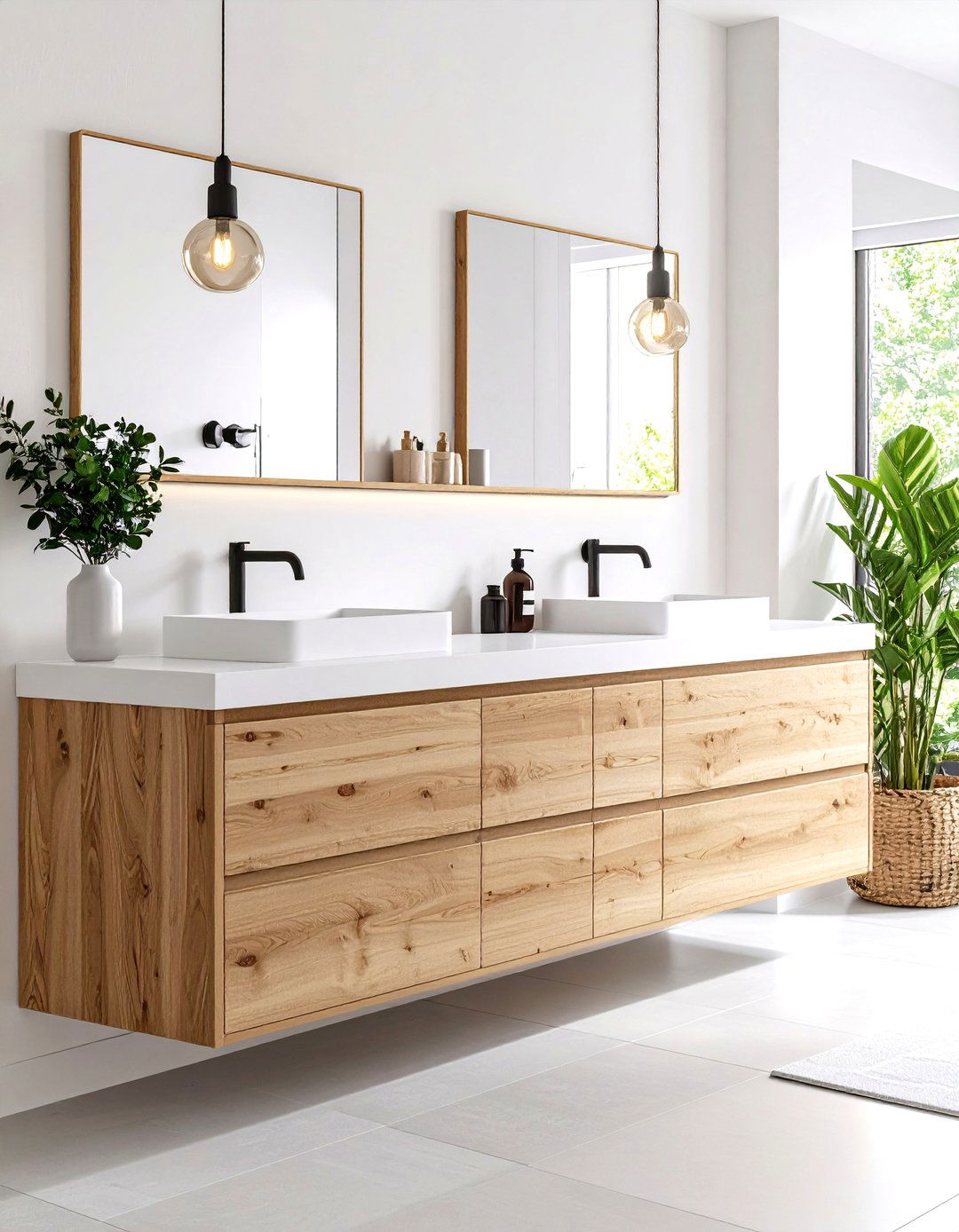
Softly grained ash trimmed in white oiled finish embodies Nordic simplicity. Thick slab sides frame wide drawers fitted with finger grooves instead of pulls, maintaining that quiet minimalism. A white solid-surface top with seamless sink reinforces the monochrome palette, while matte-black faucets provide a crisp counterpoint. To emphasize hygge comfort, line drawers with felt organizers and add a woven basket for rolled washcloths. Because ash reflects light, the vanity brightens compact baths even on gray mornings. Pair with large-format porcelain floor tiles laid in herringbone for subtle visual movement.
16. Wall-to-Wall Custom Oak Wood Bathroom Vanity Maximizes Storage
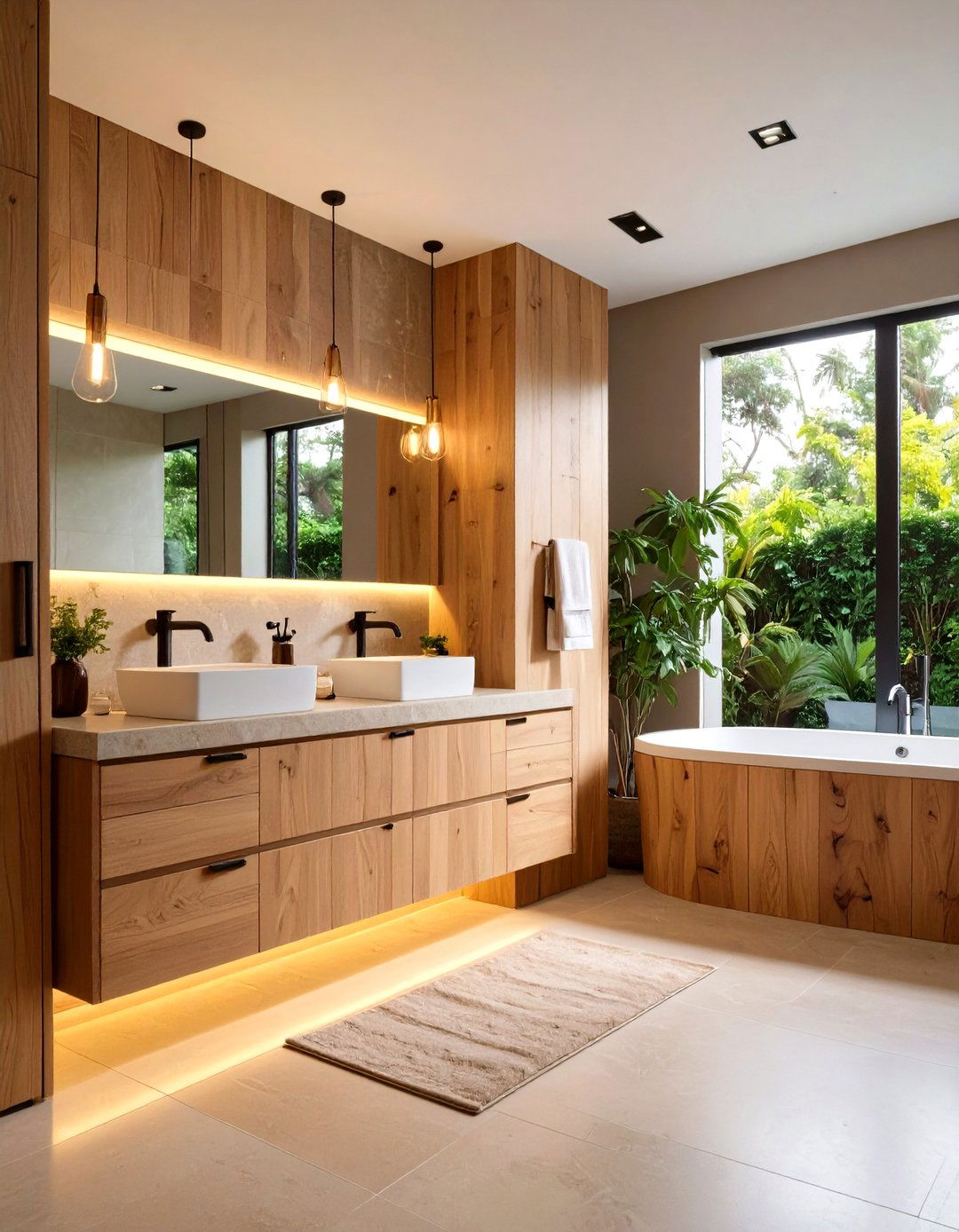
In larger primary baths, a spanning vanity fills the full width between two walls, offering hotel-level organization. Opt for rift-sawn white oak doors that resist cupping, combined with an integrated toe-kick night-light for safe midnight visits. Centralized sinks free up outer drawers for each partner’s toiletries, while tall upper cabinets hide spare towels and cleaning supplies. Because the run is long, break the mass visually with open cubbies beneath each sink — perfect for baskets or decorative ceramics. Continuous stone counters eliminate seam lines, and under-cabinet LED strips accentuate the full-length grain flow.
17. Slim Console-Style Wood Bathroom Vanity Lends Industrial Edge
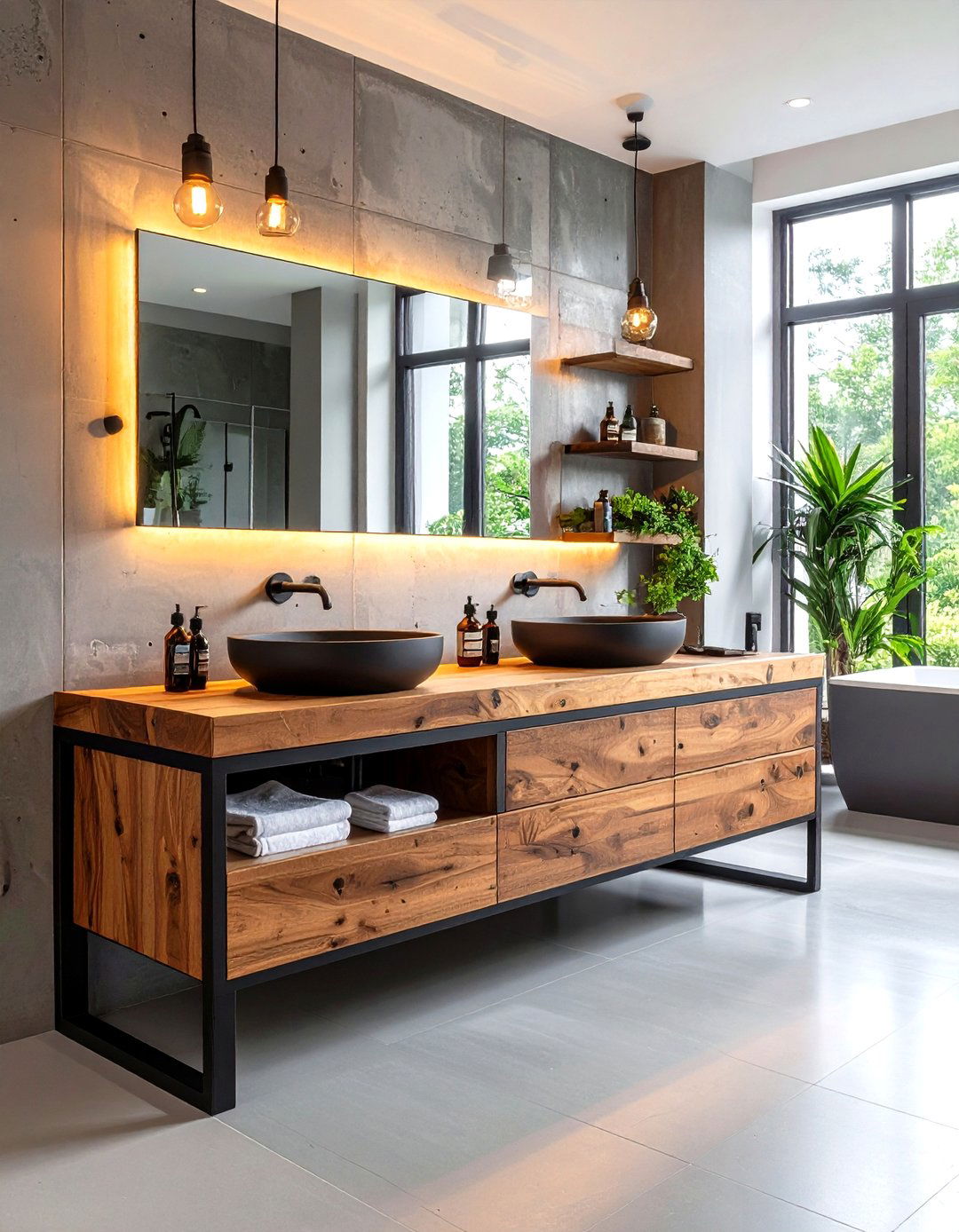
A console vanity pairs a slender timber top with sturdy metal legs, balancing warmth and urban attitude. Choose thick butcher-block walnut sealed in marine-grade oil so splashes wipe right off. Below, add a powder-coated steel shelf for spare rolls and a mesh basket of hair products. Exposed plumbing finished in matte black doubles as design element and keeps installation straightforward. Because the frame sits open, this option is ideal for tiny guest baths where closed cabinetry could feel bulky. Anchor the look with a frameless round mirror and Edison-bulb sconce for loft-inspired flair.
18. Weathered Driftwood Bathroom Vanity Evokes Coastal Ease
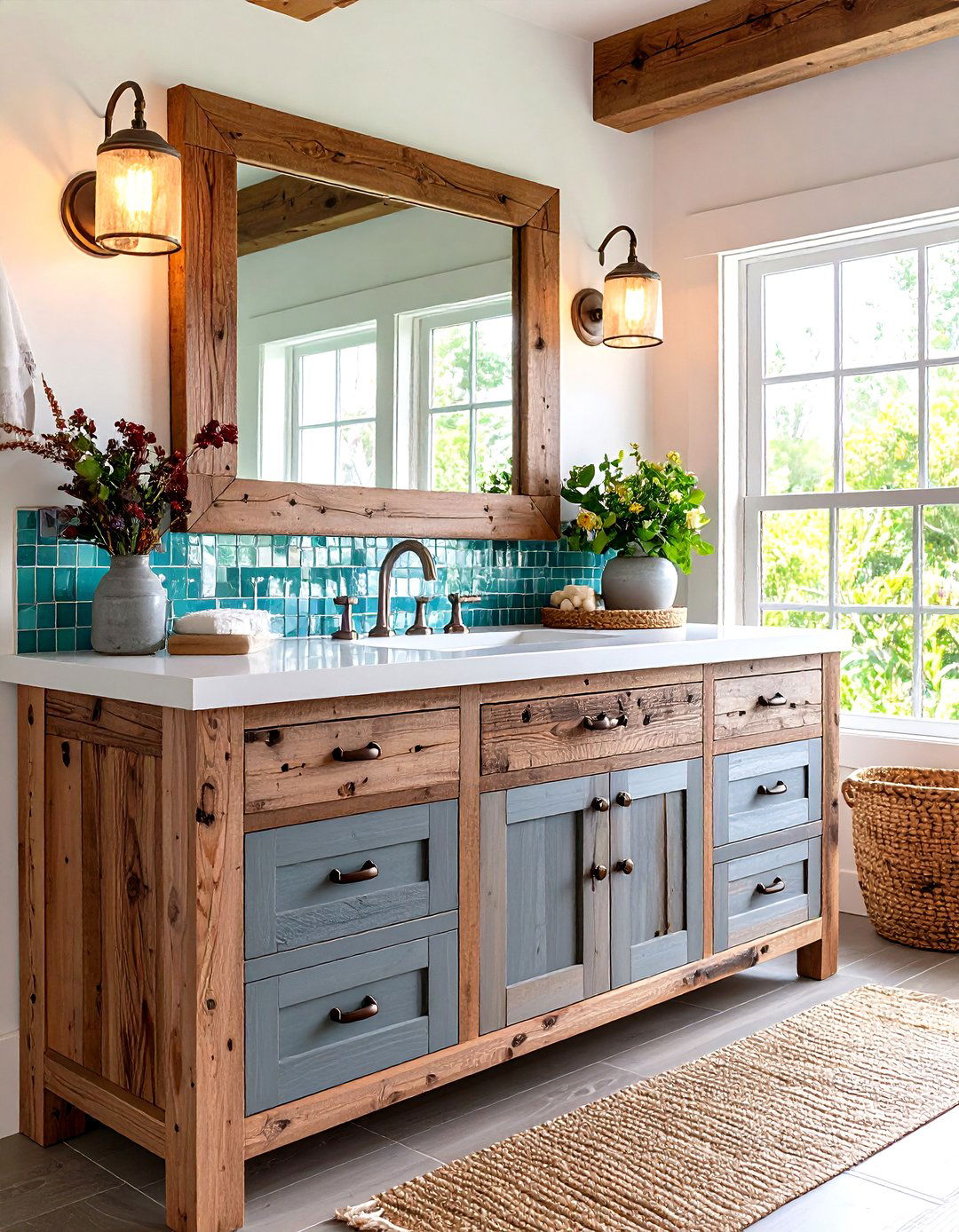
If you love beach house aesthetics, a driftwood-finished vanity brings salted-air charm inland. Start with knotty pine planks wire-brushed to accentuate grain, then wash with gray stain for that sun-bleached tone. Pair with a hammered nickel sink bowl reminiscent of seaside pails and use rope pulls for a playful nautical nod. To protect the porous wood, coat with marine spar varnish every couple of years. Complement the vanity with sea-glass subway tiles and soft-blue walls, and tuck a woven seagrass hamper underneath to complete the coastal narrative.
19. Two-Tone Painted and Natural Wood Vanity Adds Depth
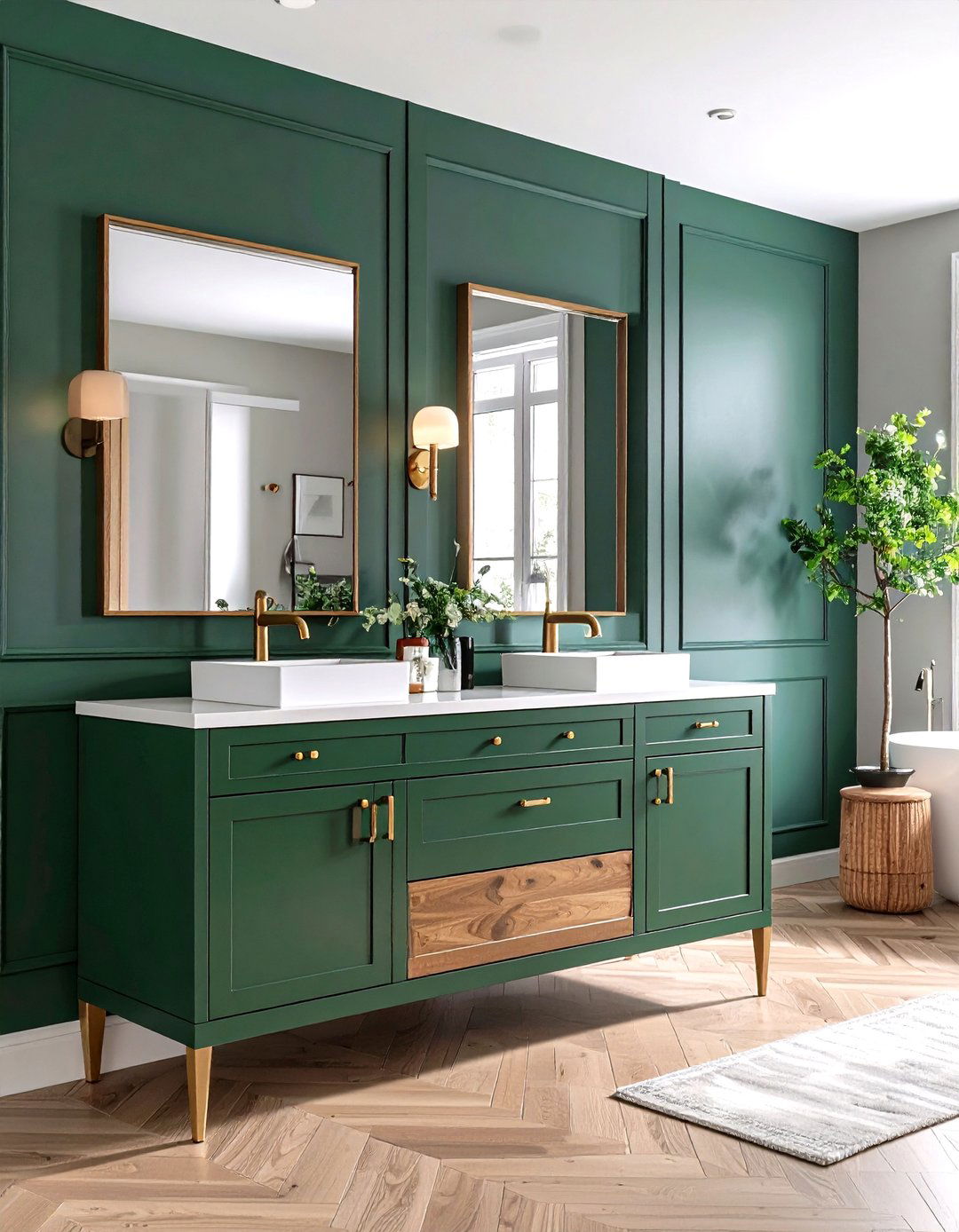
Color-blocking a vanity — leaving drawers natural while painting outer gables — creates striking contrast. Deep forest green frames highlight warmly oiled oak fronts, or reverse the scheme with charcoal drawers amid maple surround. The paint guards high-touch edges against grime, while exposed grain keeps connection to nature. Use concealed hinges for a sleek face, then repeat the accent color on window trim for cohesion. Because two-tone pieces already carry strong personality, stick to simple round knobs in matte brass or black. This flexible approach lets you update the paint down the road without replacing the solid wood core.
20. Ribbed Drawer-Front Wood Vanity Offers Subtle Modern Detail

Ribbed or tambour-style drawer fronts bring linear movement without overwhelming small bathrooms. Builders route shallow horizontal grooves across solid oak panels before finishing with clear lacquer. The texture hides everyday scuffs, and integrated channel pulls keep the lines uninterrupted. Mount the vanity slightly above the baseboard to maintain that floating impression, then light from above with a narrow beam spotlight to throw micro-shadows along each rib. Because the pattern feels contemporary, combine with matte-black wall taps and a rectangular vessel sink for cohesive modernity.
21. Floating Wood Vanity With Built-In Plant Shelf Invites Nature
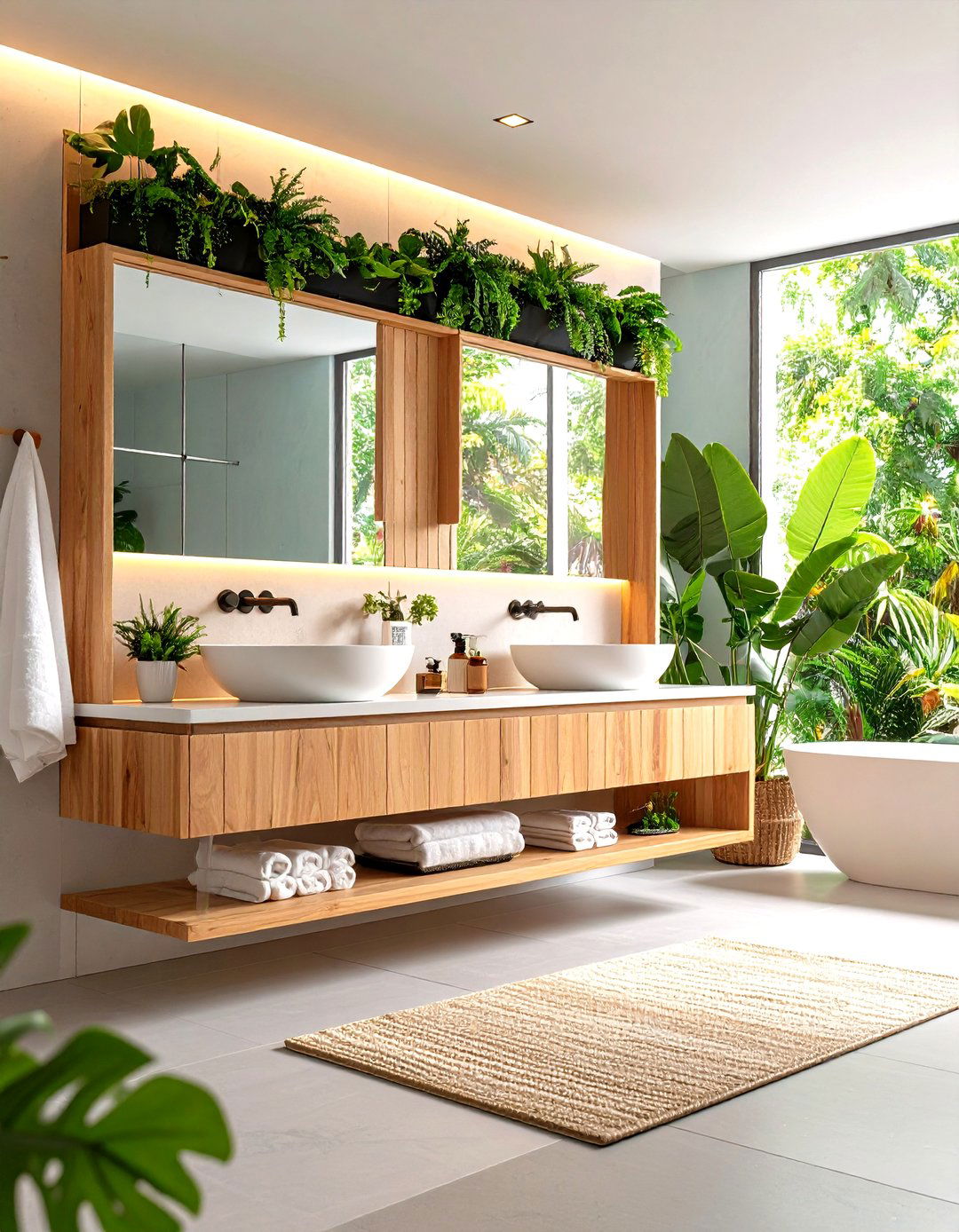
Bringing greenery into the bath boosts mood and air quality; a slim ledge behind the sink dedicated to potted pothos or ferns integrates biophilic design. Choose a teak or cedar ledge resistant to humidity and angle it slightly toward the basin to catch incidental mist. Hidden drip trays beneath pots protect the timber below. This extra shelf also hides the faucet supply lines for a tidier view. Coordinate the vanity wood species with matching floating towel bars nearby to create a unified nature-inspired theme. Good ventilation keeps both plants and timber happy.
22. Modular Wood Bathroom Vanity Adapts As Needs Change
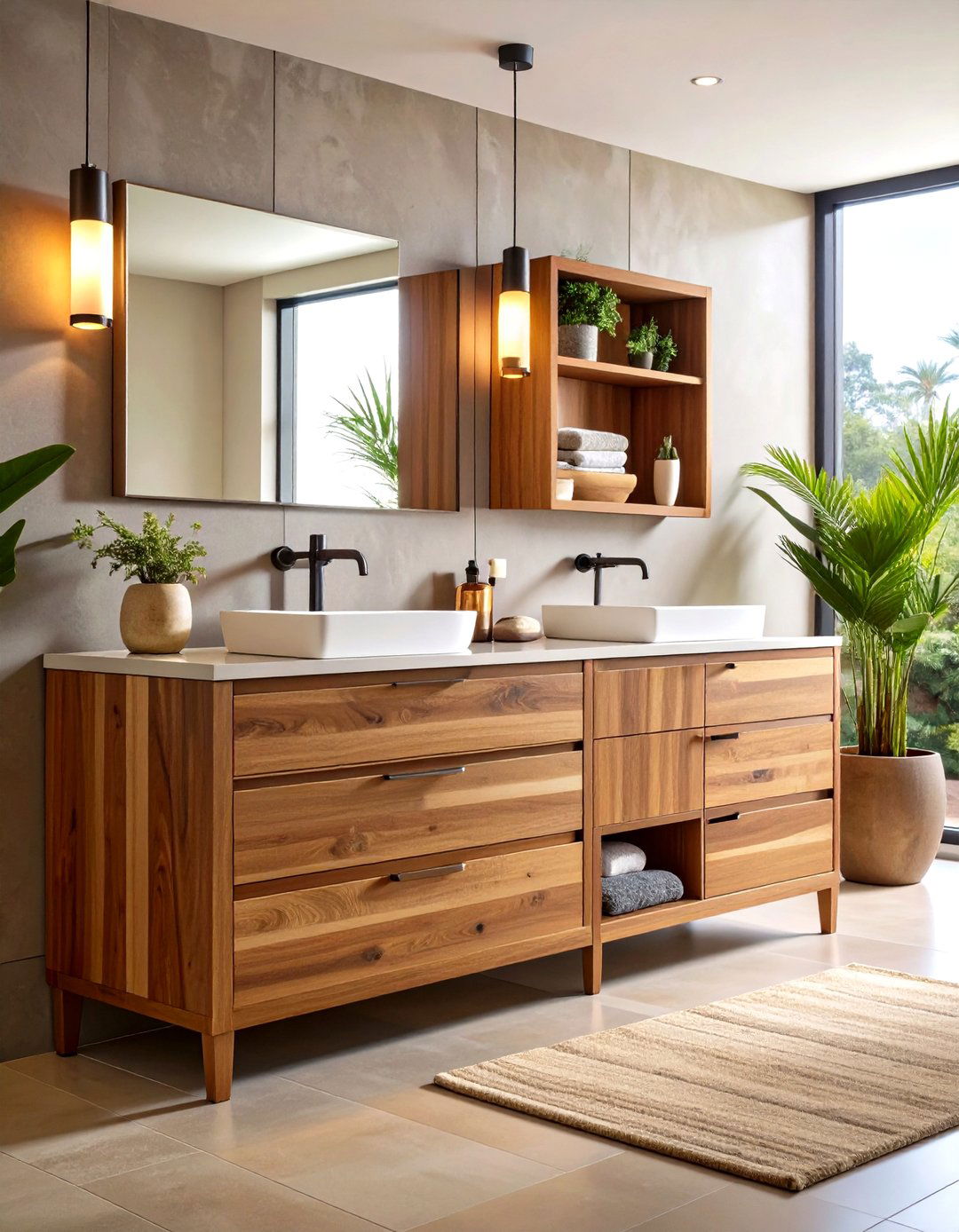
Families evolve, and a modular vanity system — separate base cabinets, drawer towers, and open cubes — lets you rearrange layout without full demolition. Many 2025 lines use birch plywood boxes faced with oak or walnut slabs, connected via hidden cam locks for quick adjustments. Start with a 36-inch sink base, then slide in a narrow pull-out for hair tools or swap for a hamper cabinet down the line. Adjustable interior shelves accommodate changing bottle heights, while soft-close hardware preserves peace. Investing in flexible cabinetry now saves landfill waste and renovation costs later.
23. Compact 24-Inch Wood Vanity Maximizes Powder Room Style
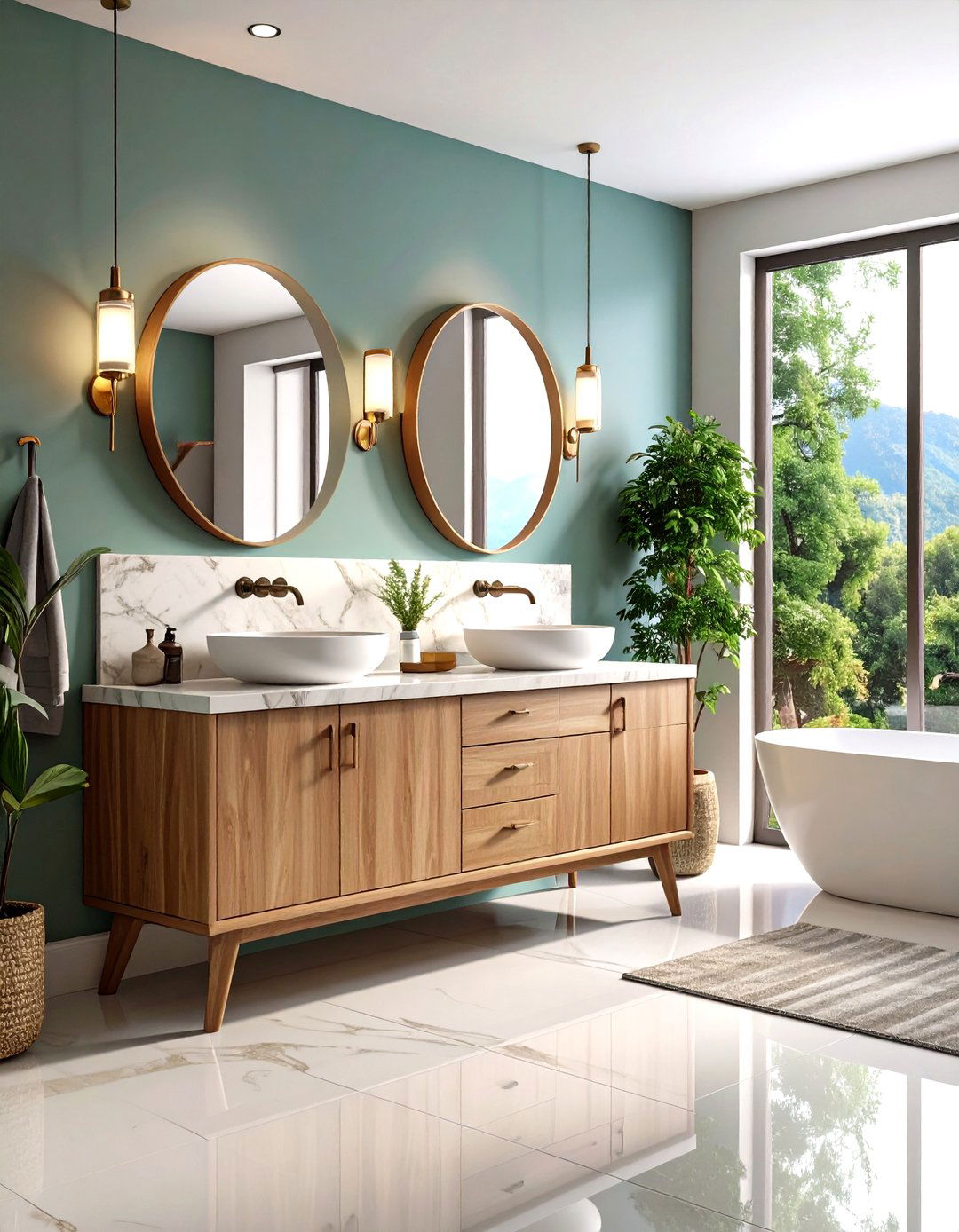
Small doesn’t have to mean bland. A 24-inch freestanding vanity in natural maple offers just enough storage for guest-bath essentials while injecting organic personality. Look for slim shaker doors that keep the face interesting without bulky rails, and add a tilt-out drawer beneath the sink to stash extra soap bars. Because floor area is tight, choose tapered legs that lift the base slightly, creating visual breathing room. A petite marble top with integrated backsplash protects the wall from enthusiastic hand washers. Finish with an oval mirror to soften the boxy footprint.
24. Curved Wood Bathroom Vanity Softens Hard Tile Lines
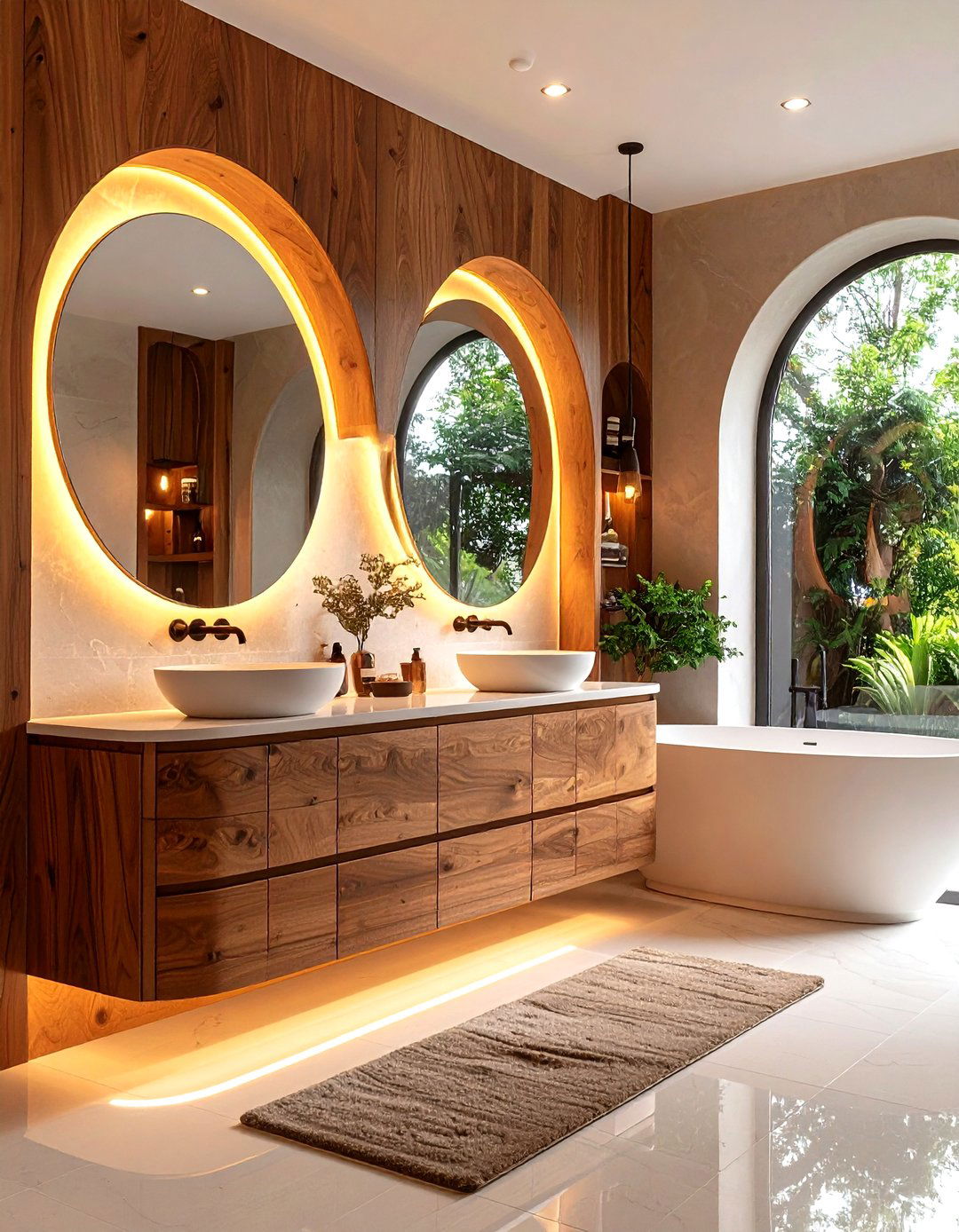
Bathrooms often overload on sharp right angles; introducing a bowed-front walnut vanity breaks repetition and improves flow in narrow rooms. The gentle curve gains a few inches of walkway clearance at the edges while providing deeper center storage. Fabrication involves laminating thin wood strips over a curved mold, producing a stable shell sealed in polyurethane. Pair with similarly arched mirrors and sconces for harmony. Keep drawer hardware minimal — small tab pulls tucked at the sides preserve the uninterrupted wave. Under-cabinet lighting traces the curve at night, spotlighting the vanity’s sculptural form.
25. Upcycled Pallet-Wood Bathroom Vanity Champions Sustainability
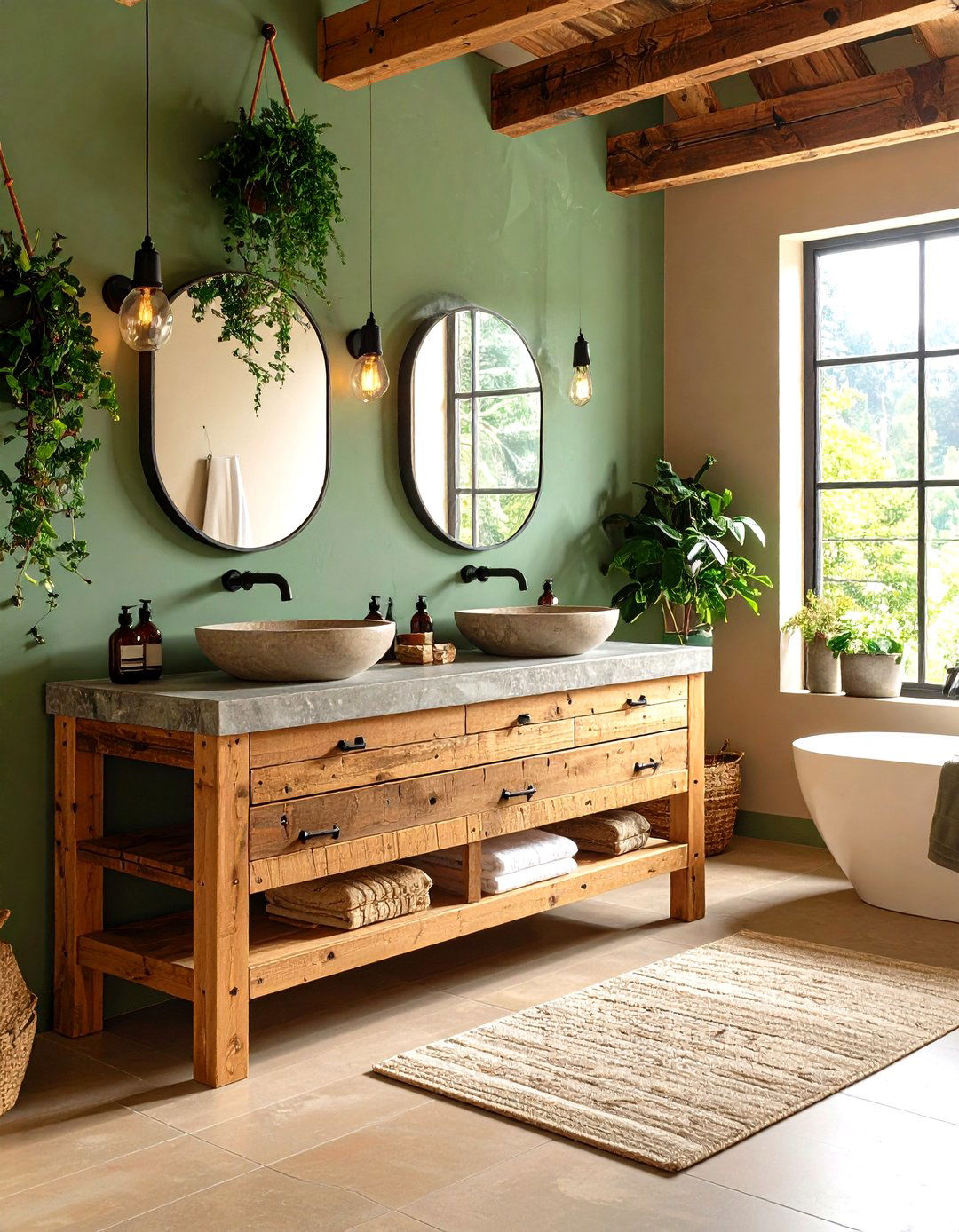
For a budget-friendly, planet-positive project, turn heat-treated pallets into a rustic vanity frame. Disassemble planks, sand smooth, and plane to consistent thickness before constructing a simple box joined with pocket screws. Reinforce inside corners with metal brackets for longevity, then top with a thrifted stone remnant to handle drips. A food-safe hard-wax oil repels moisture while highlighting the mixed-species mosaic of pine, oak, and poplar. Finish with black iron pipe legs for industrial flair and install a wall-mount faucet to free counter space. This DIY approach diverts lumber from landfills and leaves plenty of change for new towels.
Conclusion:
Wood bathroom vanities prove that functional storage can double as art, whether you lean toward sleek Scandinavian ash, heritage walnut, or eco-smart bamboo. By matching species, finish, and form to your space and lifestyle, you’ll gain a durable centerpiece that resists humidity while nurturing daily rituals. From floating slabs with hidden tech to vintage dresser conversions bursting with character, the ideas above show how responsibly sourced timber can anchor even the most contemporary bath in nature’s calming warmth. May your chosen grain pattern greet you each morning with beauty, purpose, and a touch of everyday serenity.


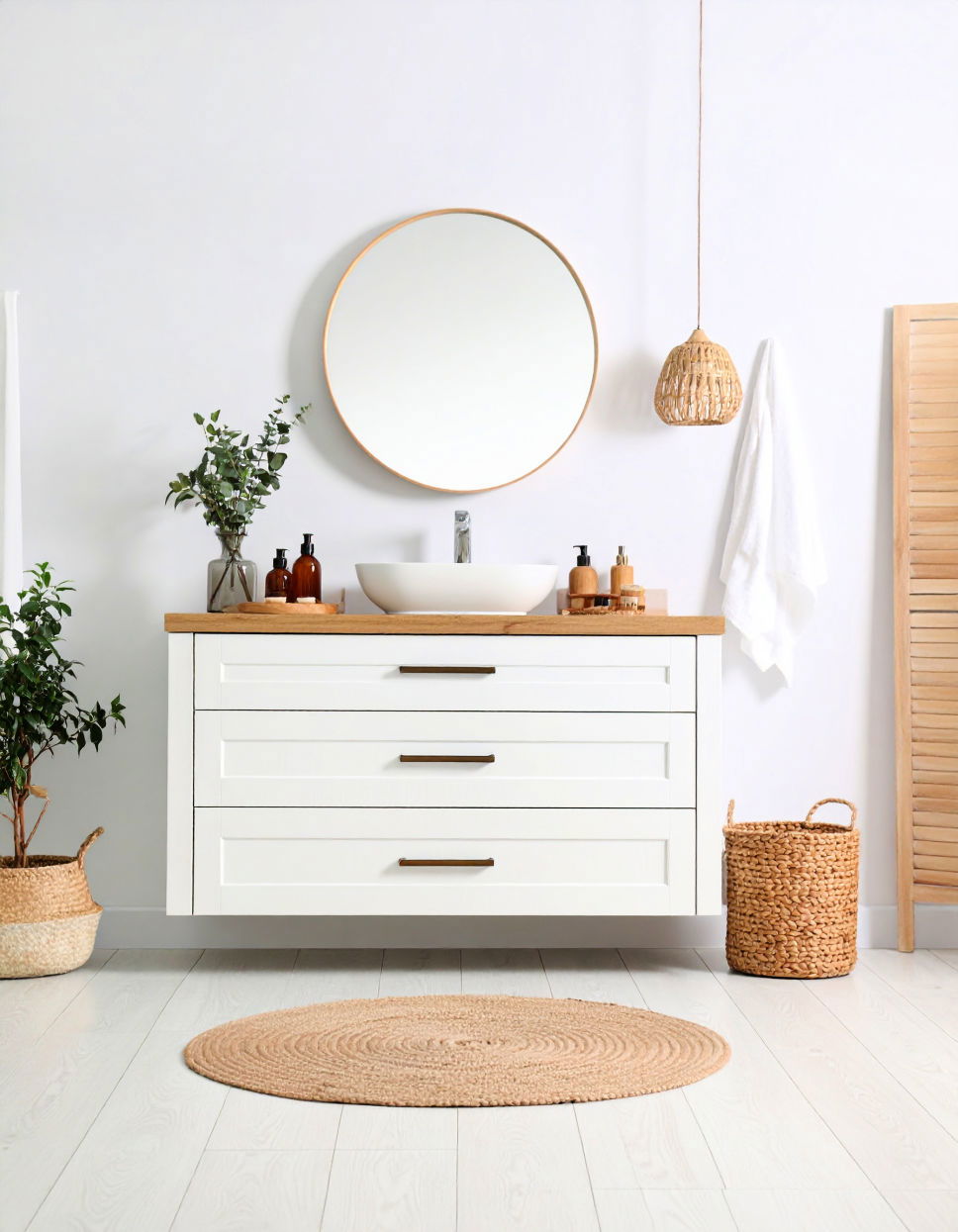
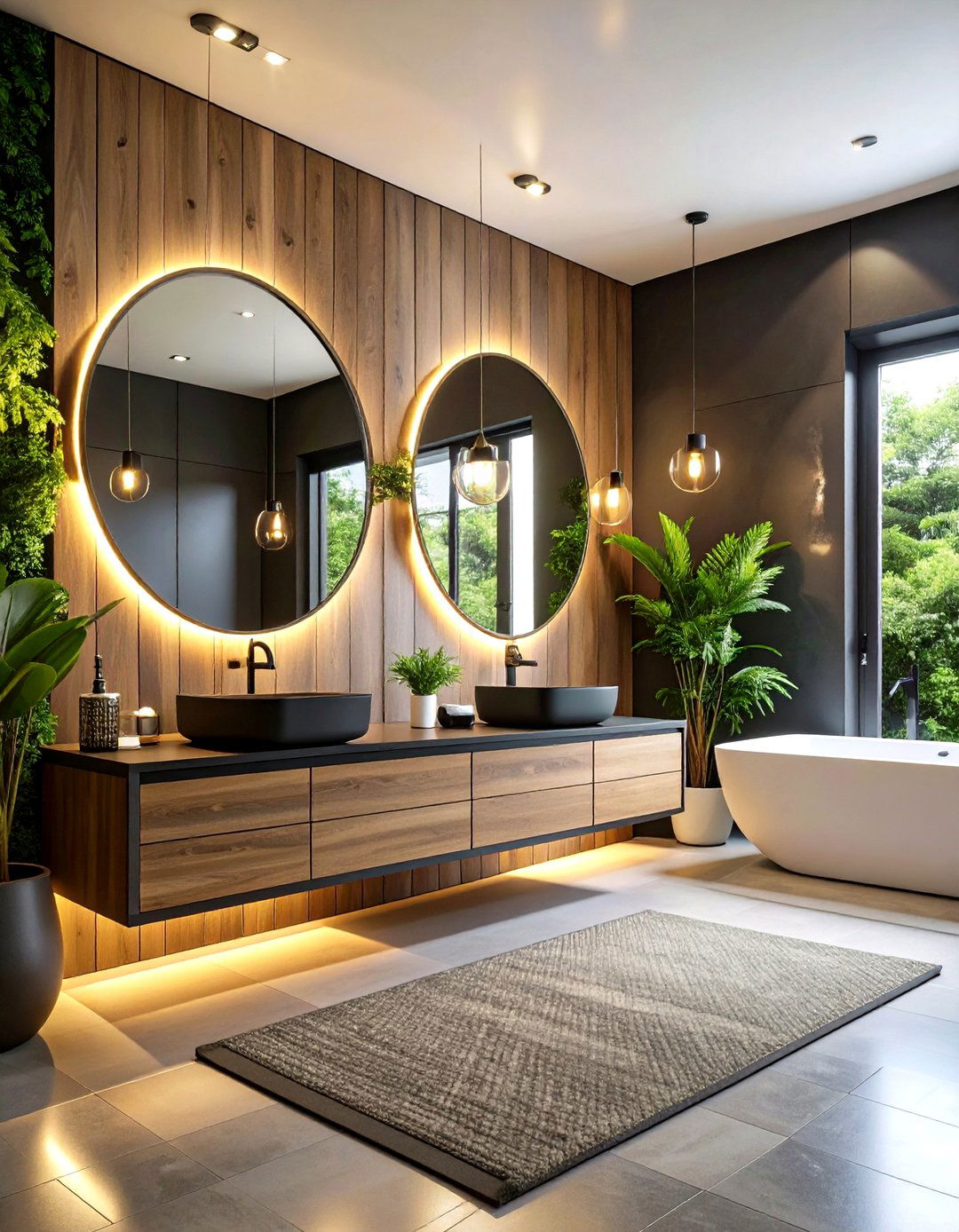
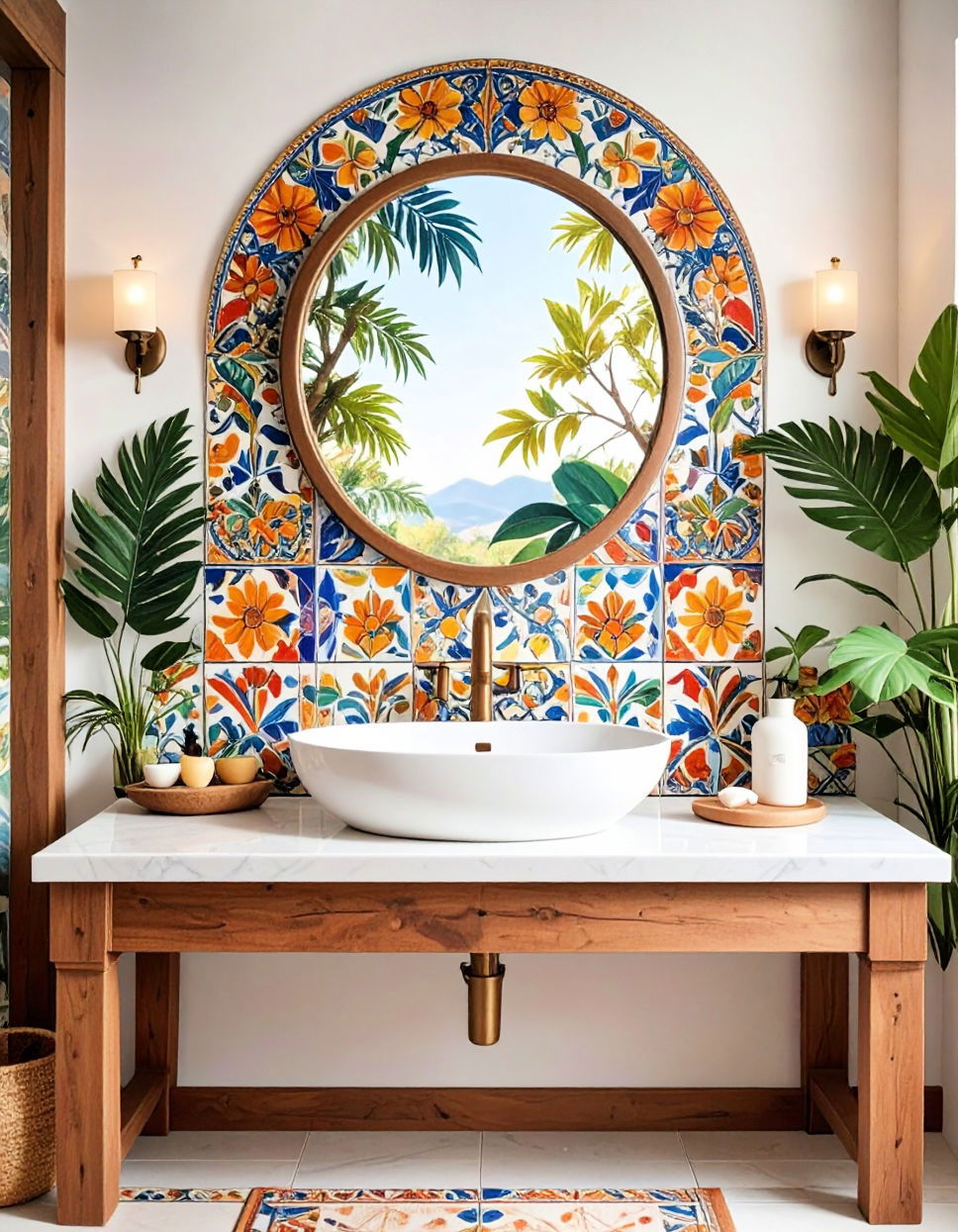
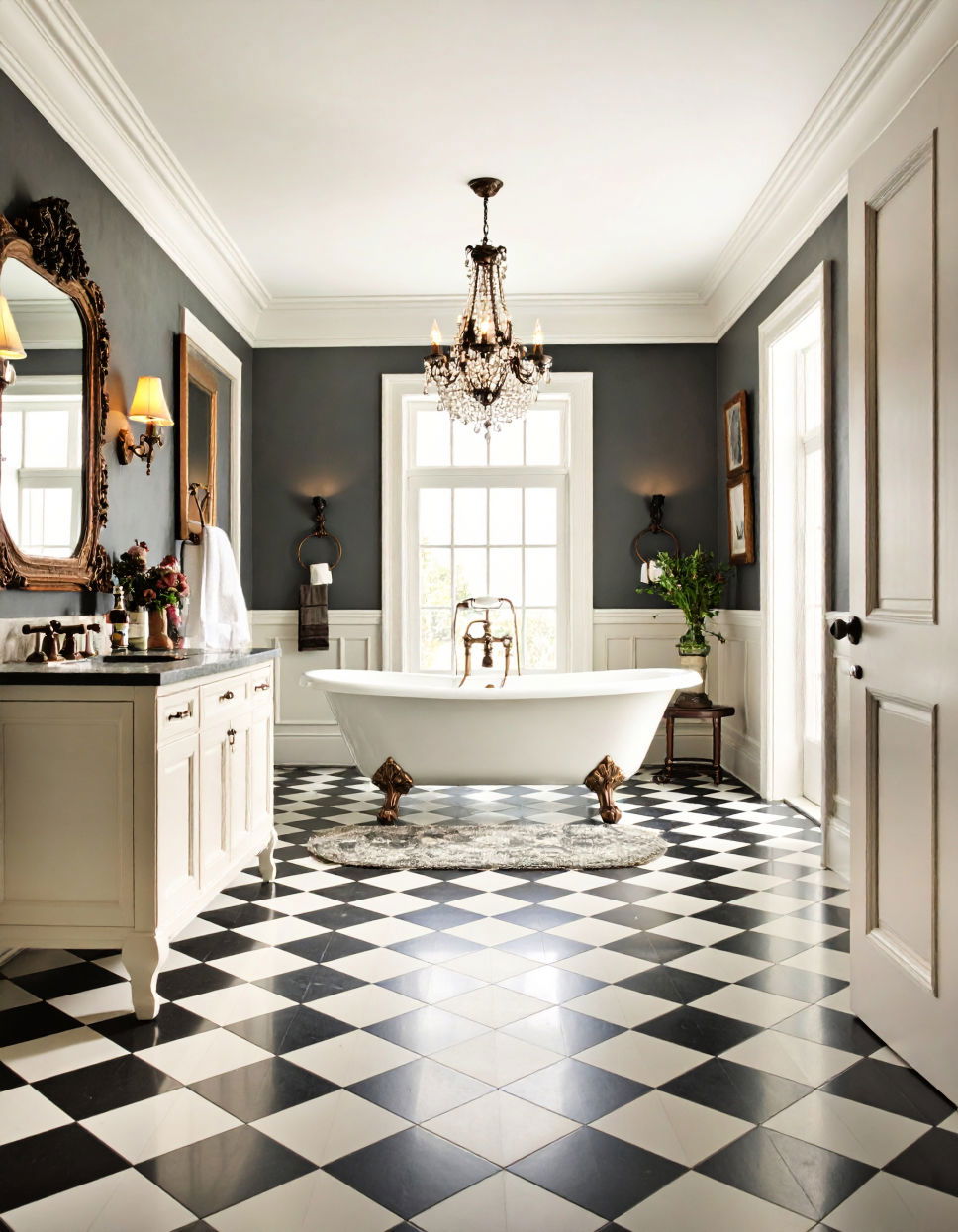
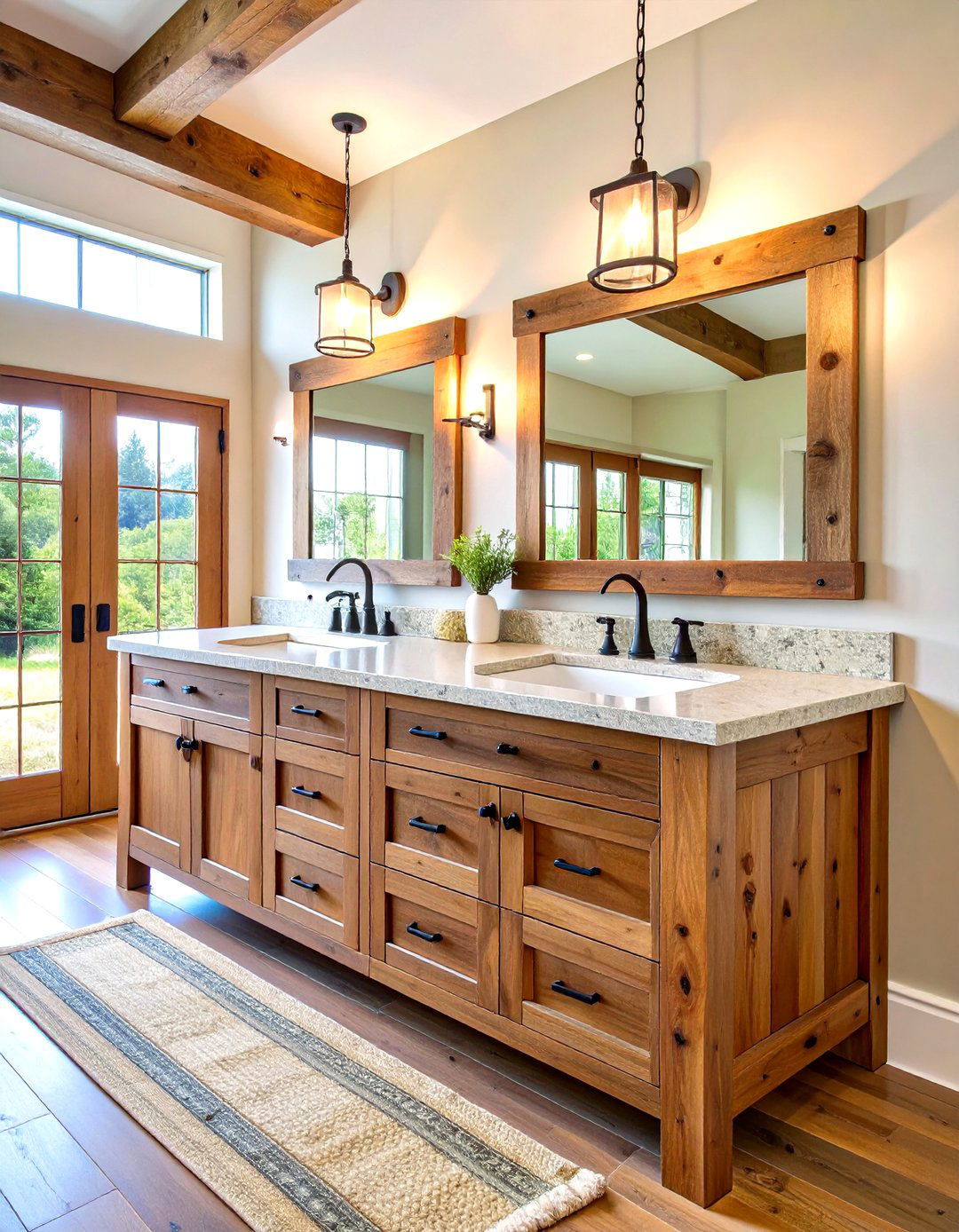
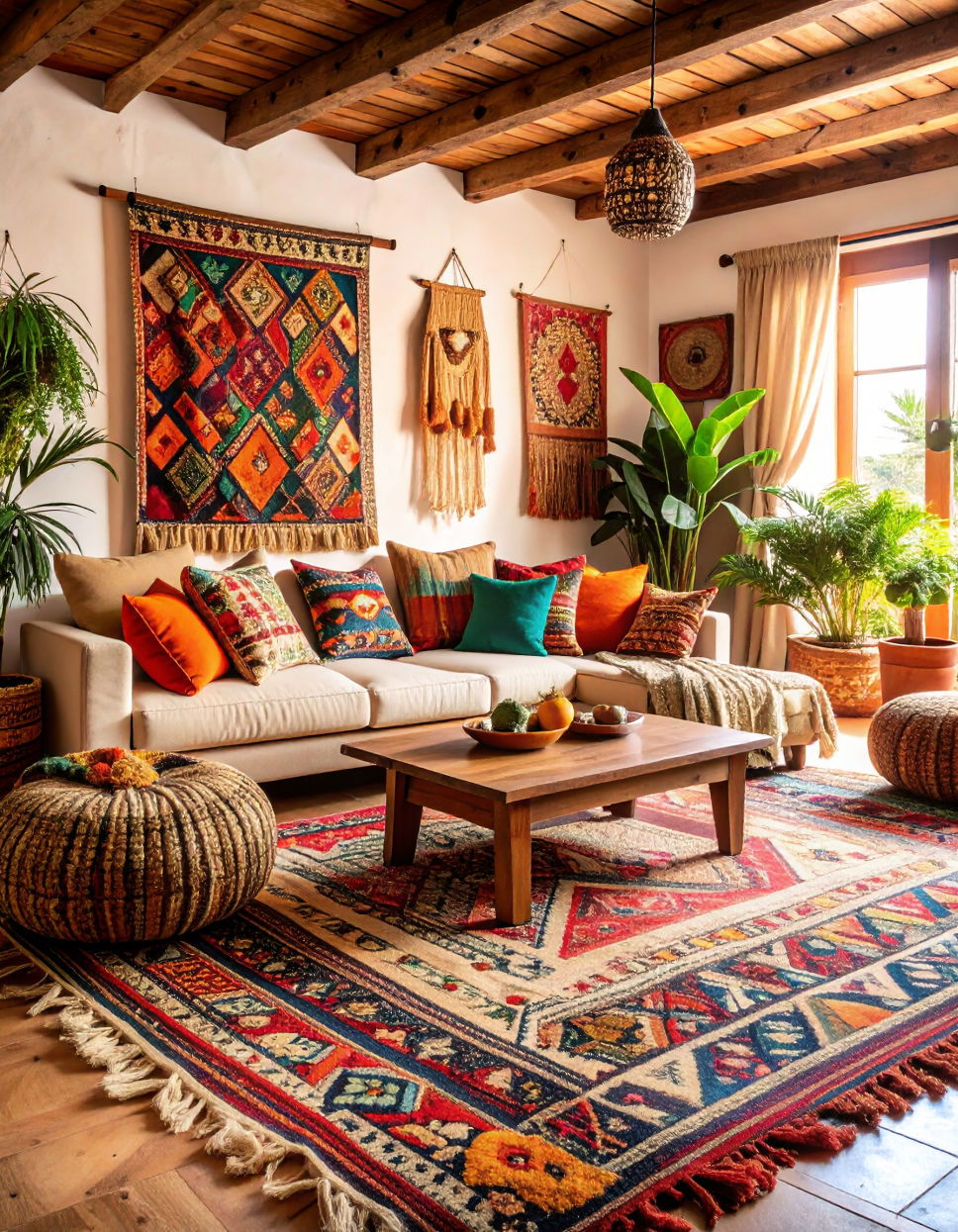
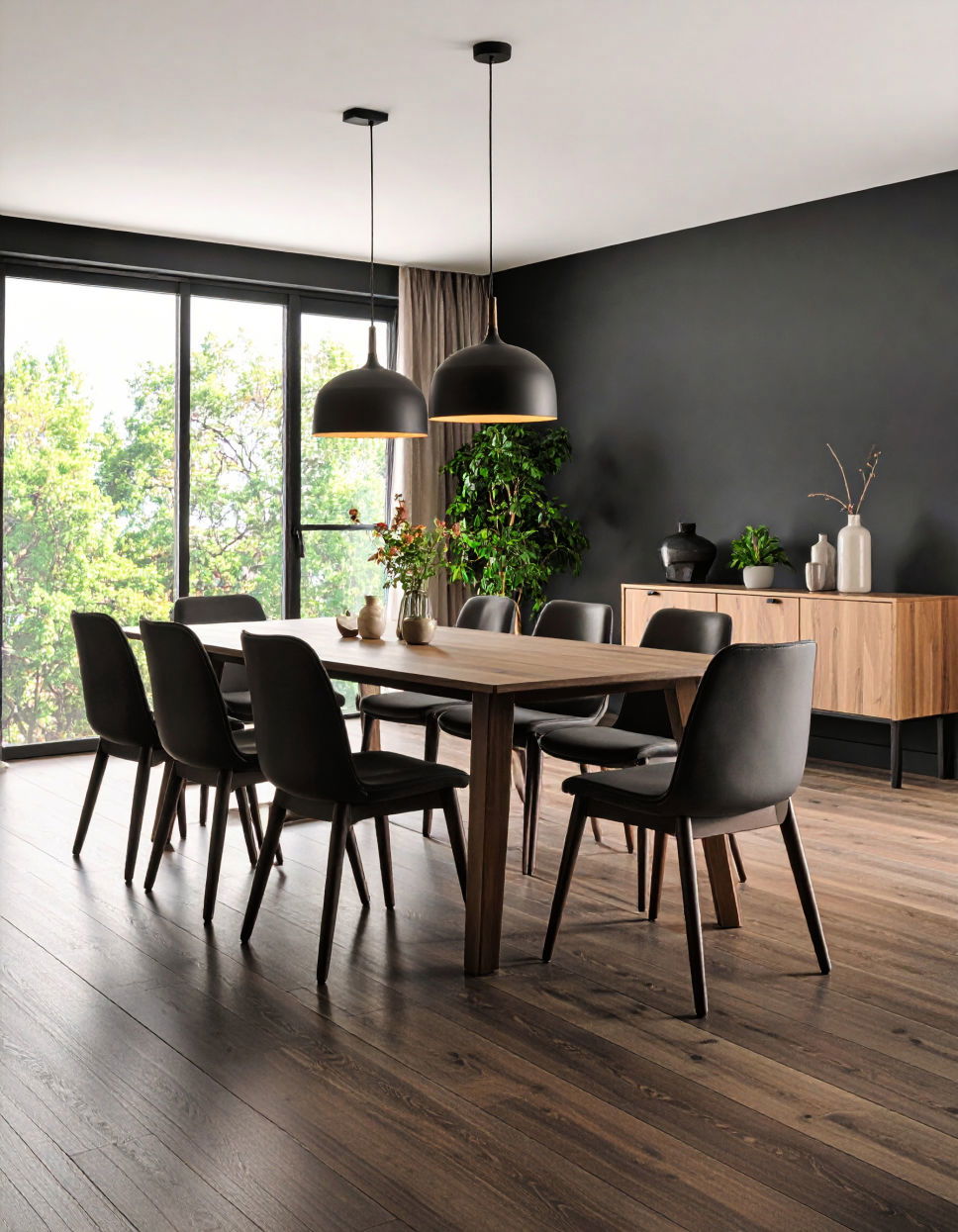
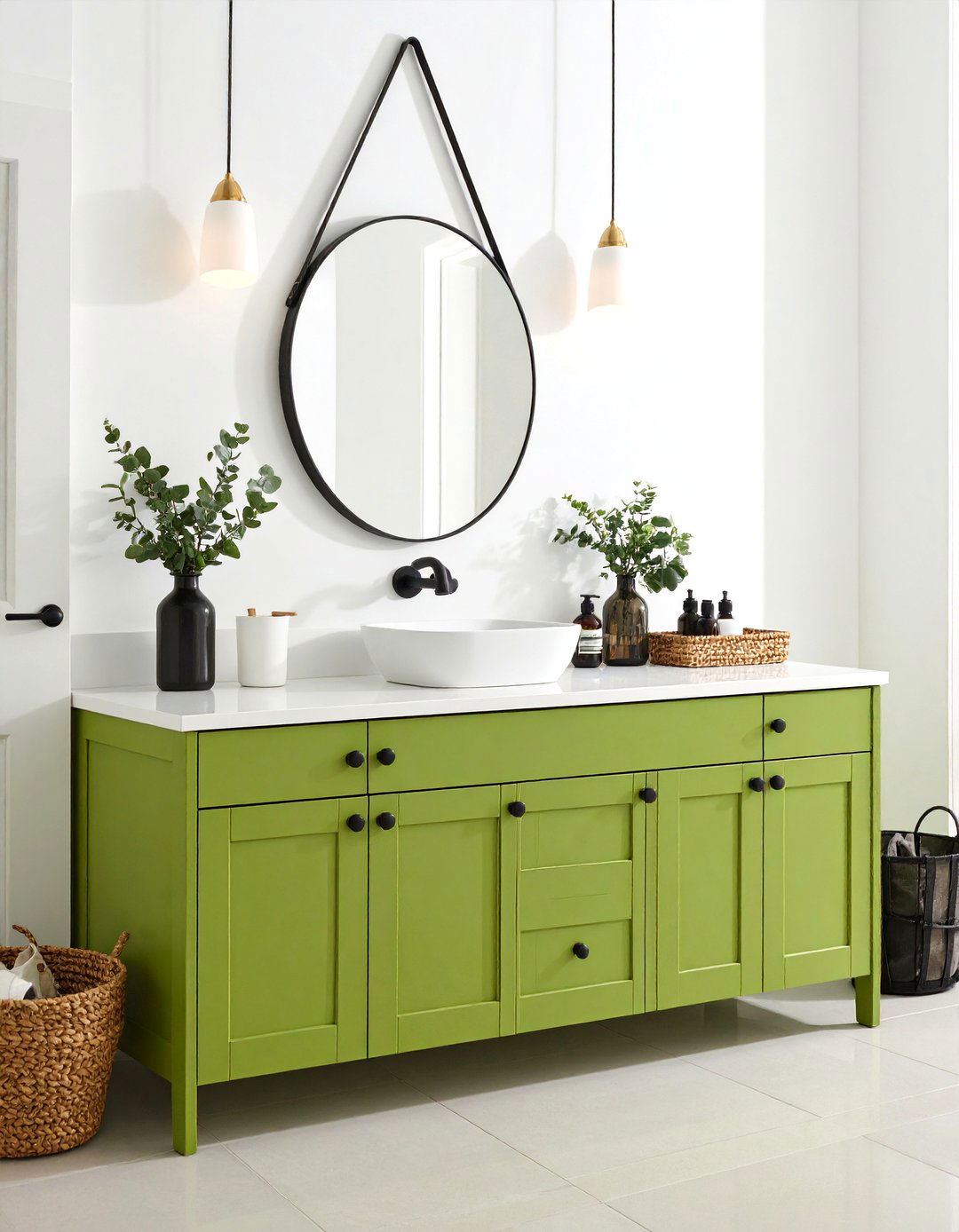
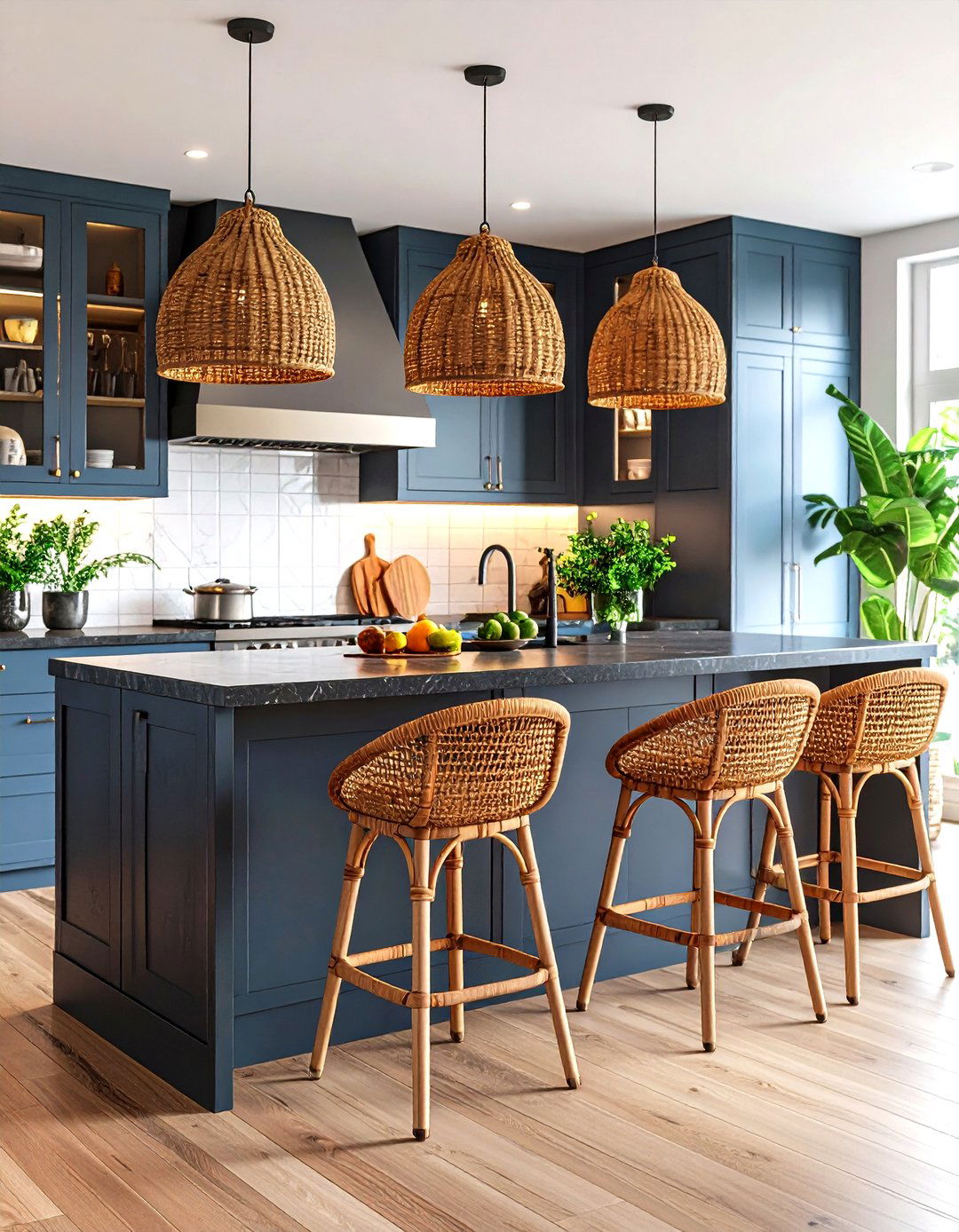
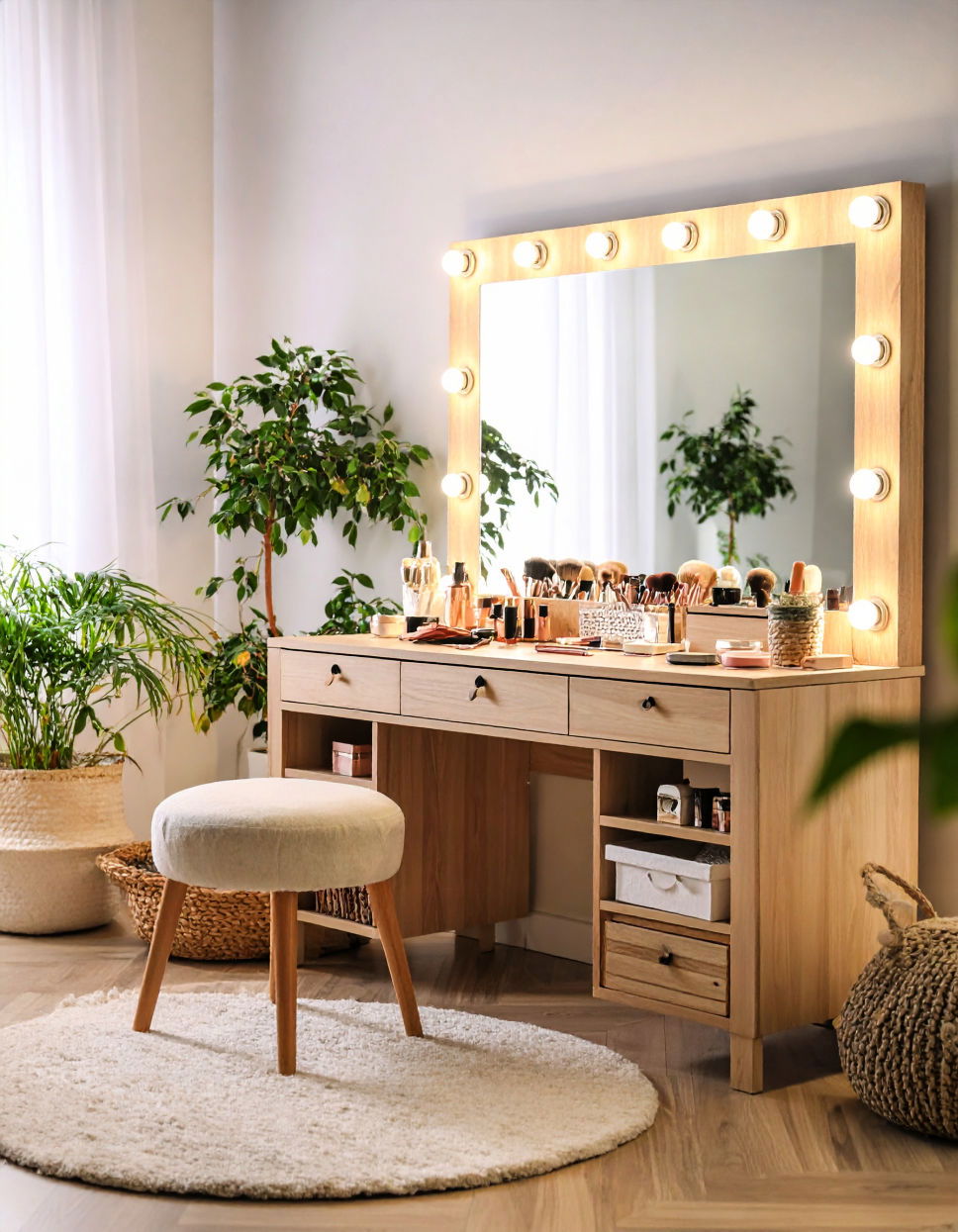
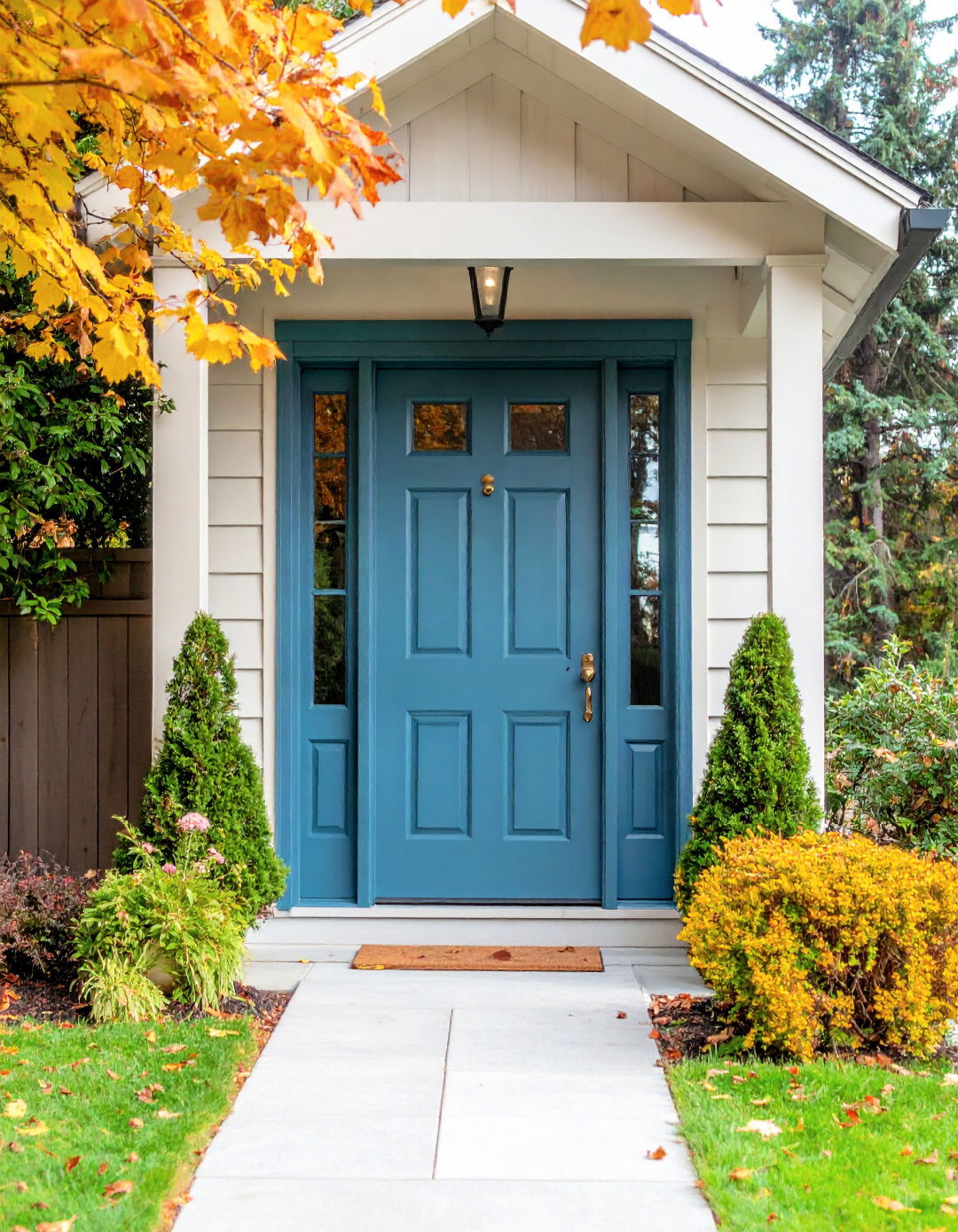
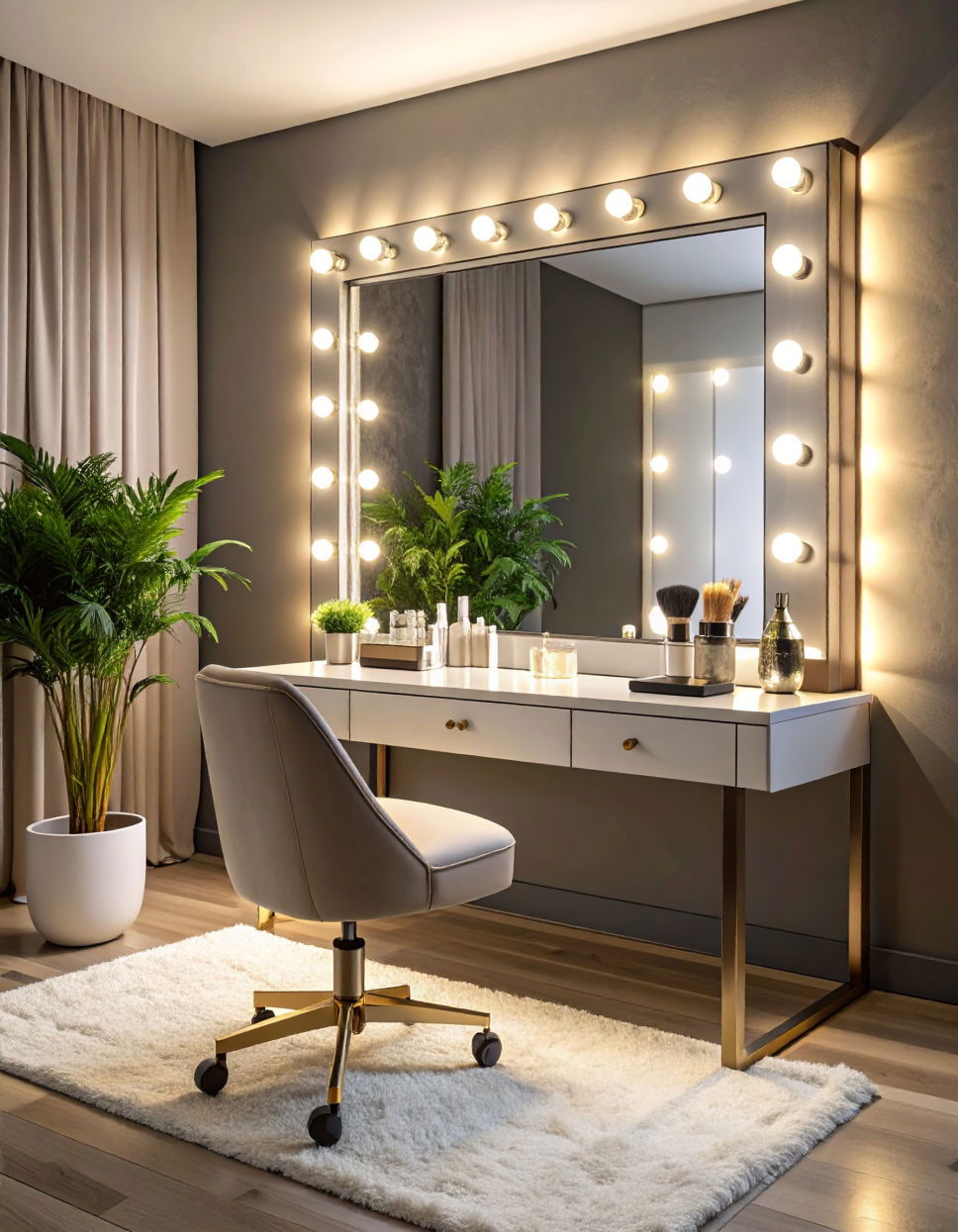
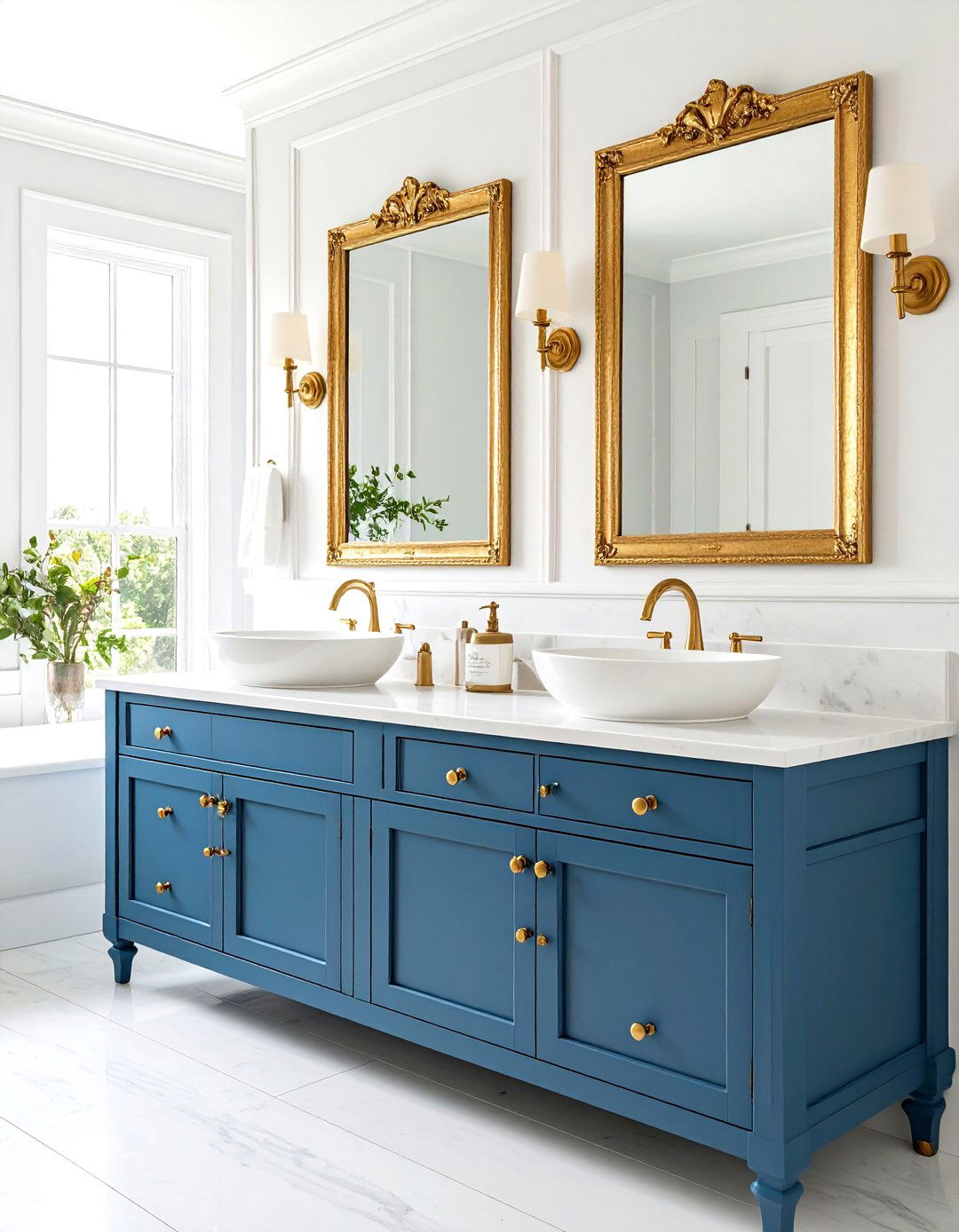
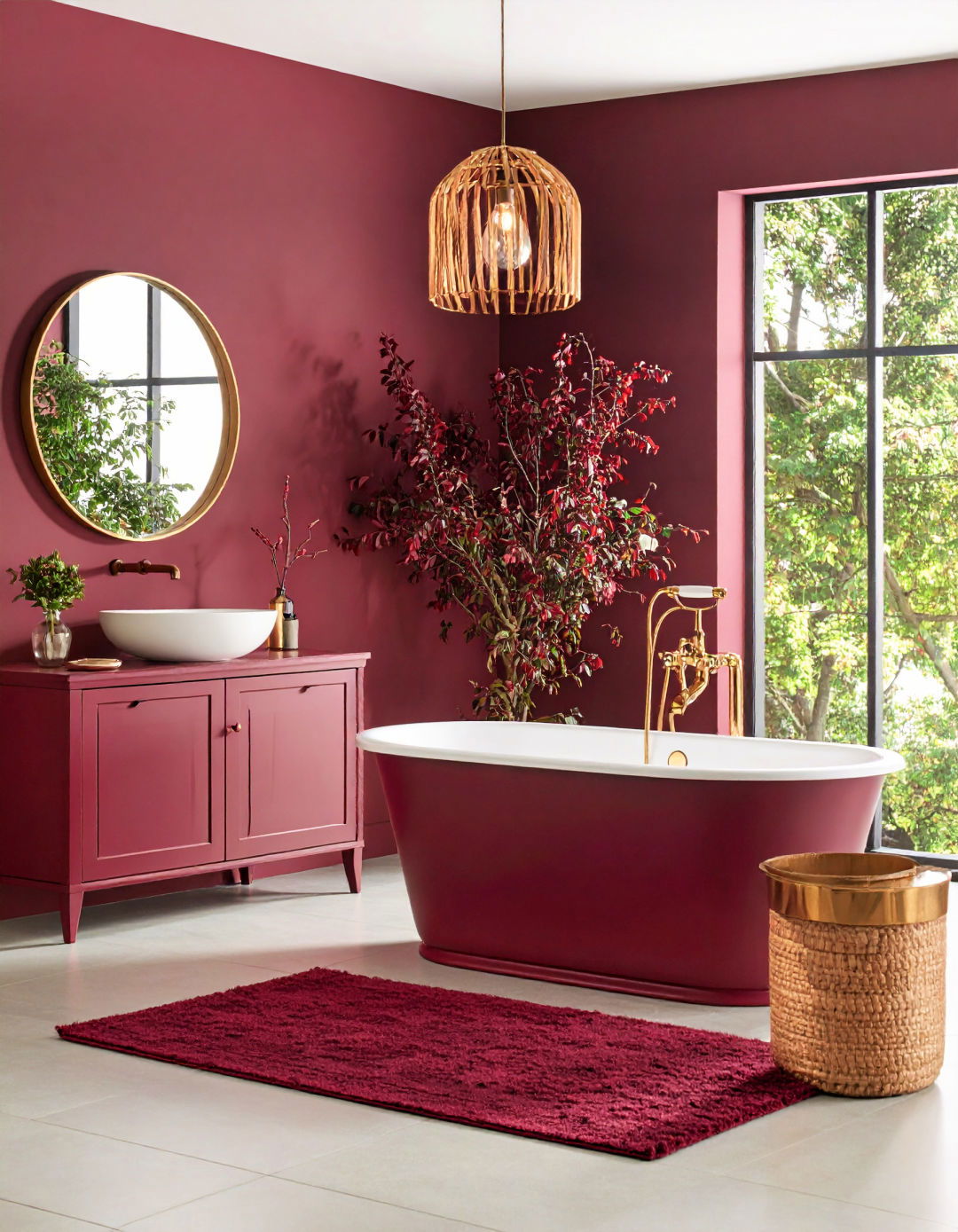
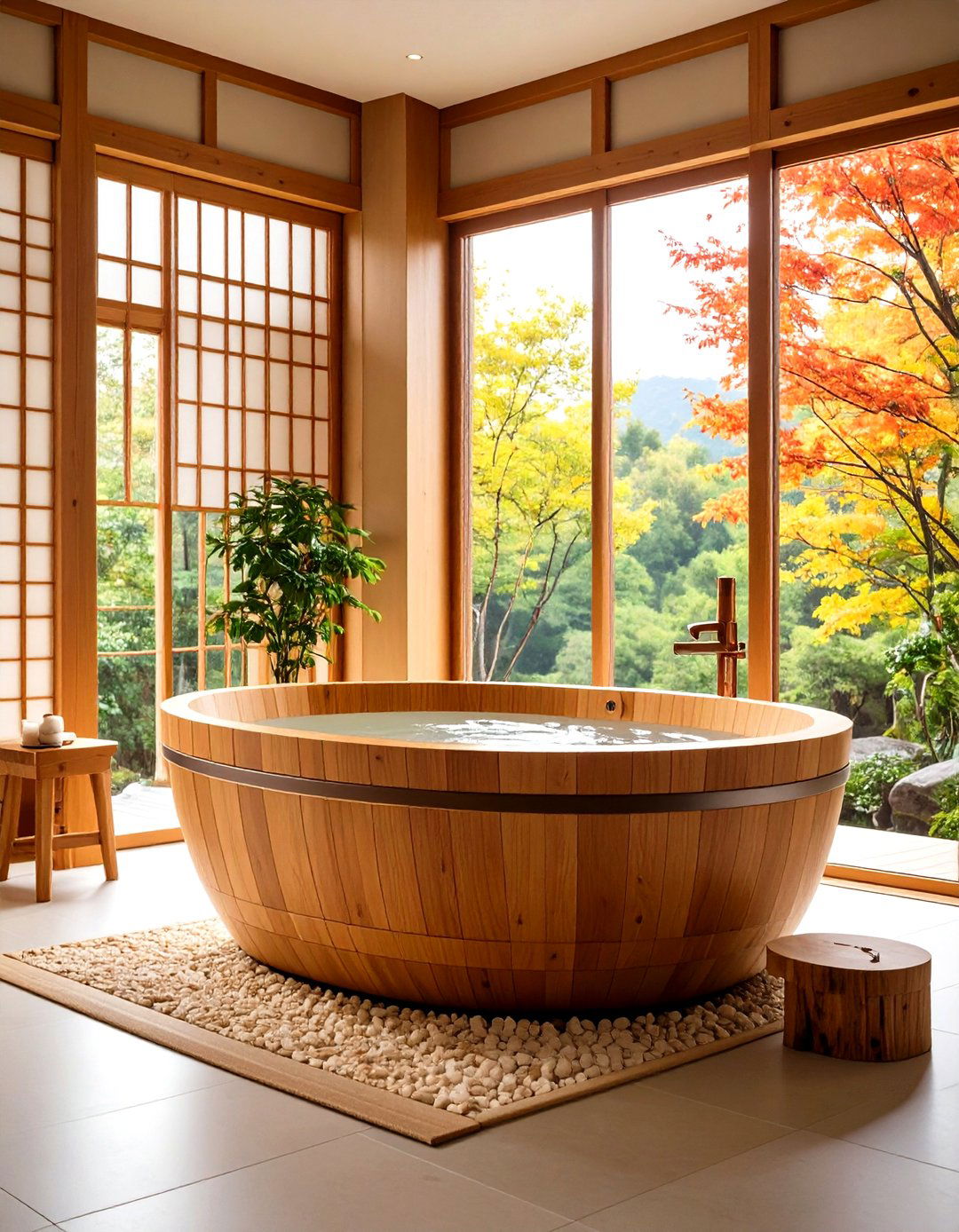
Leave a Reply